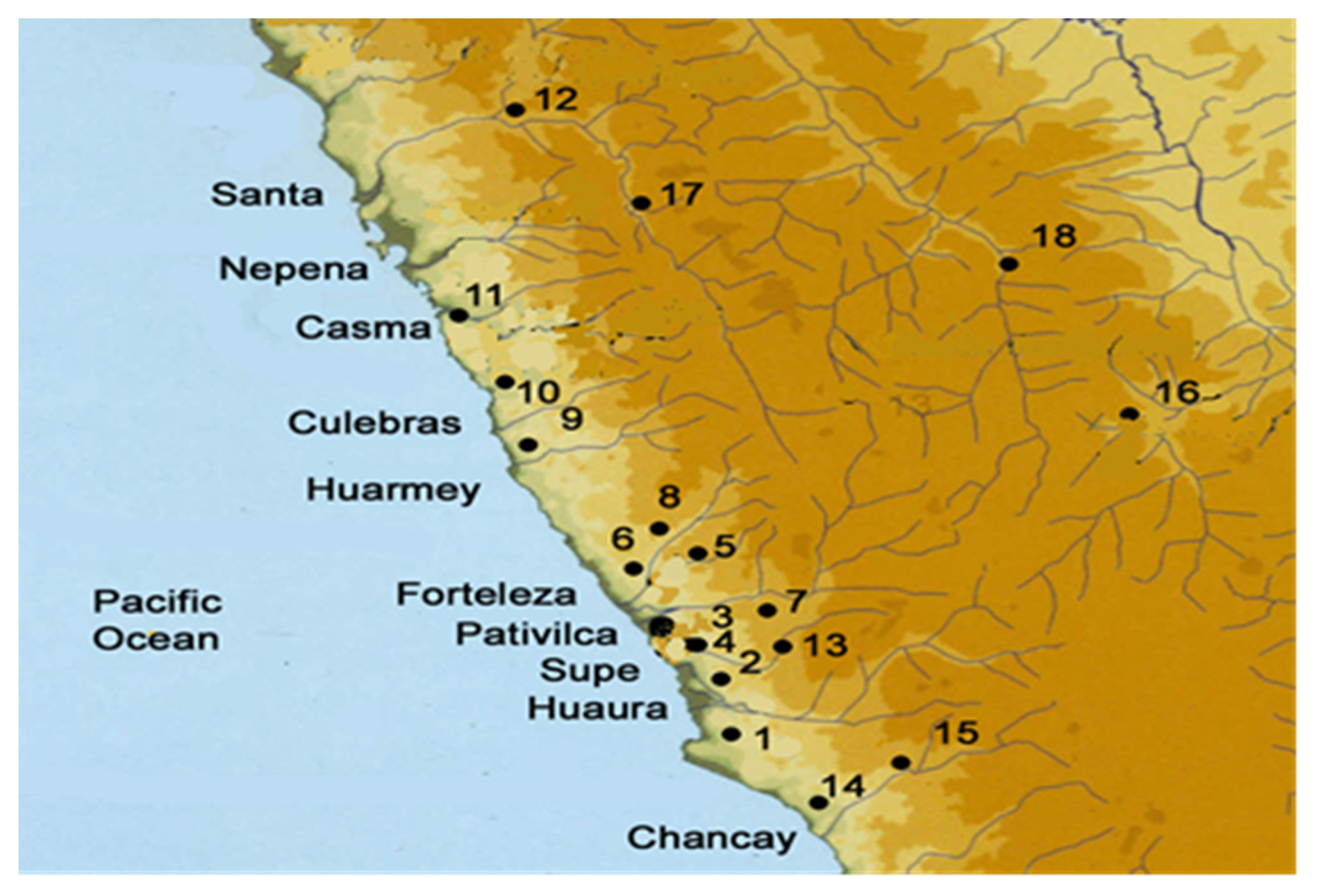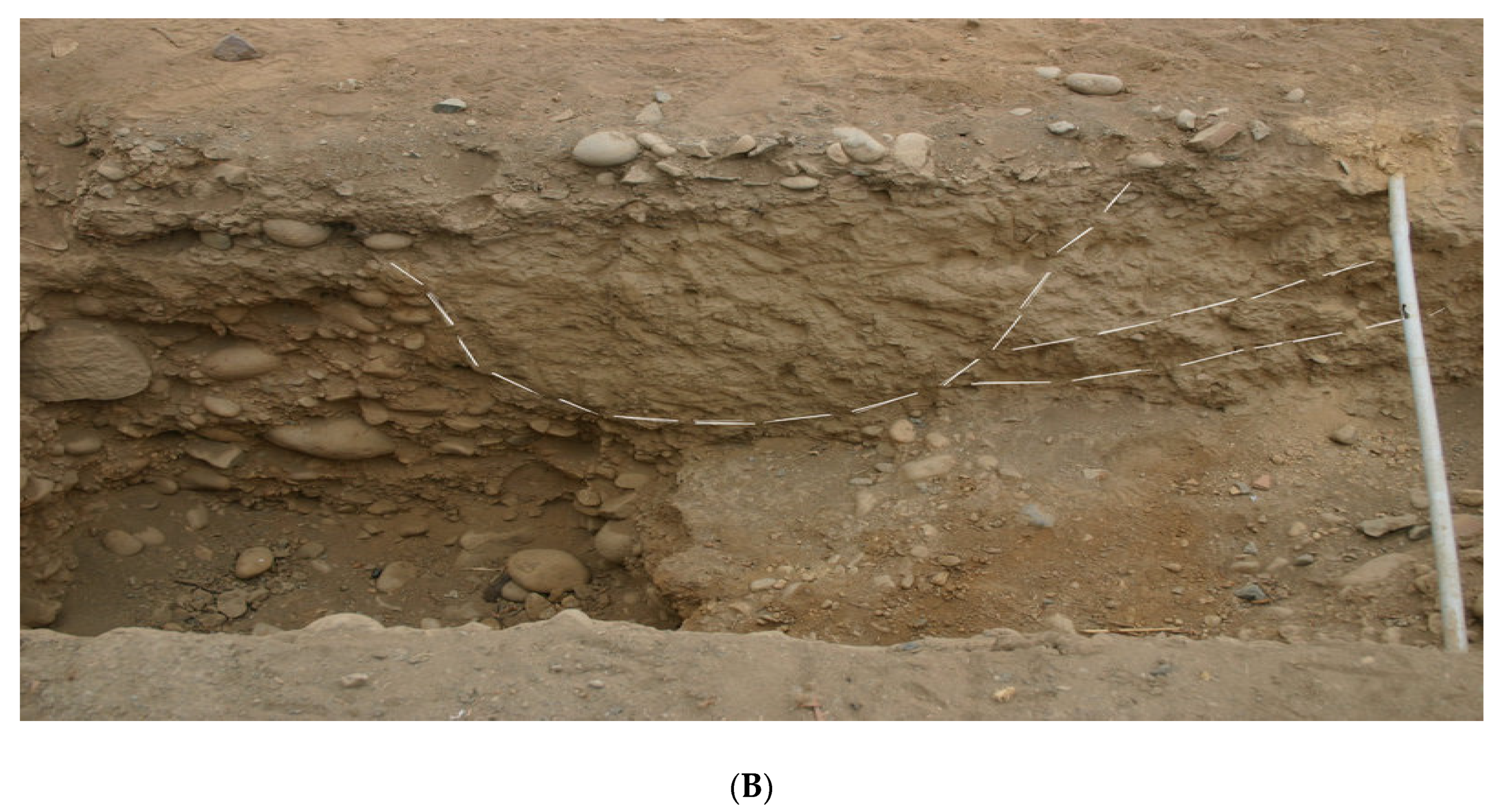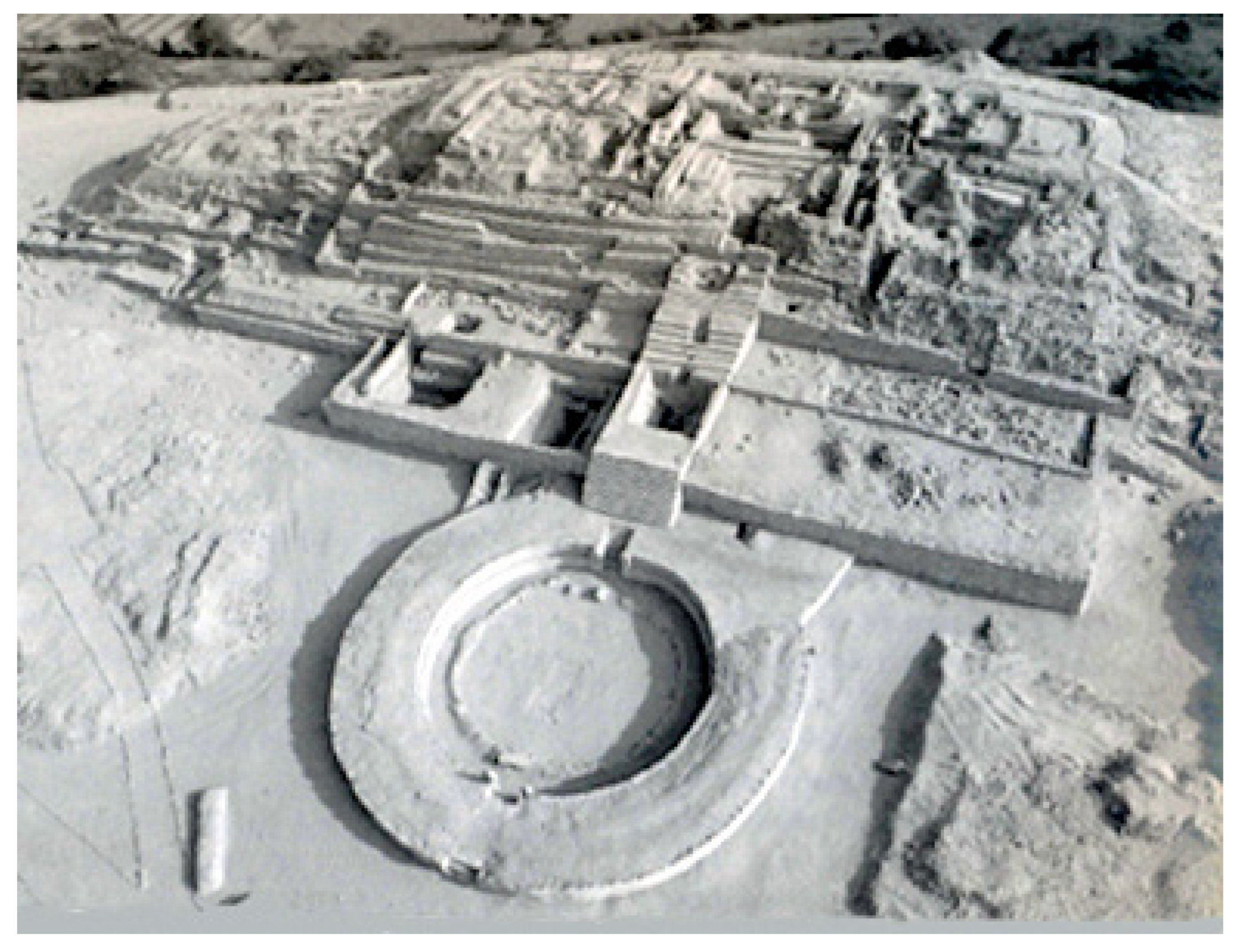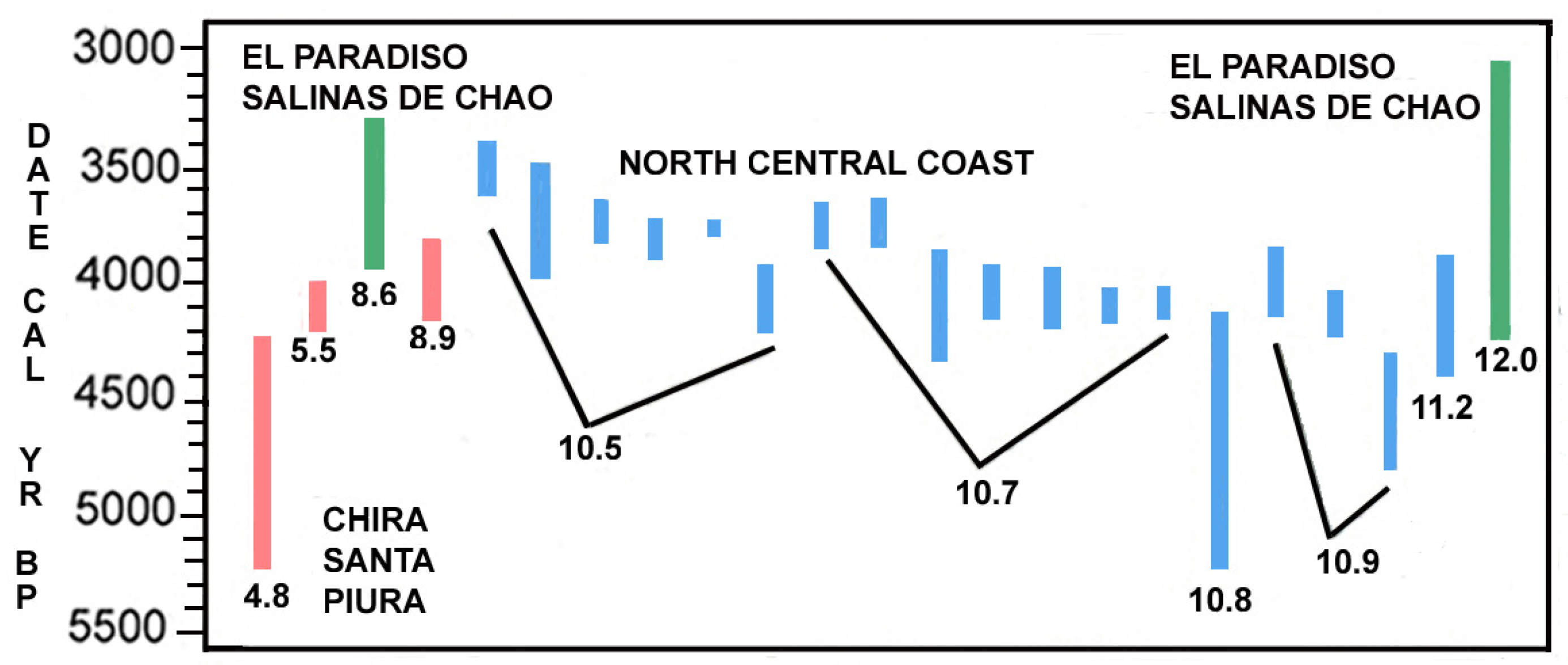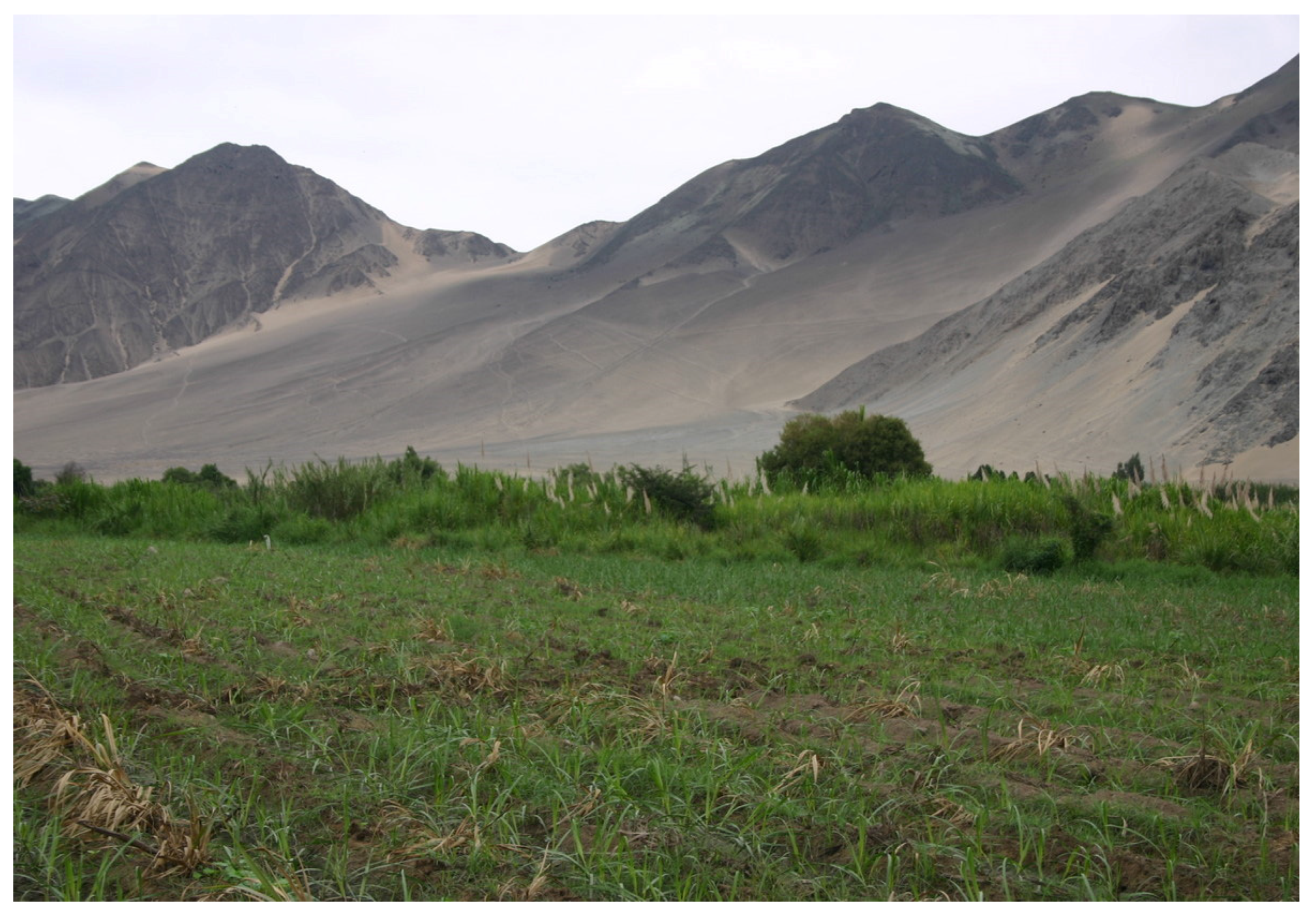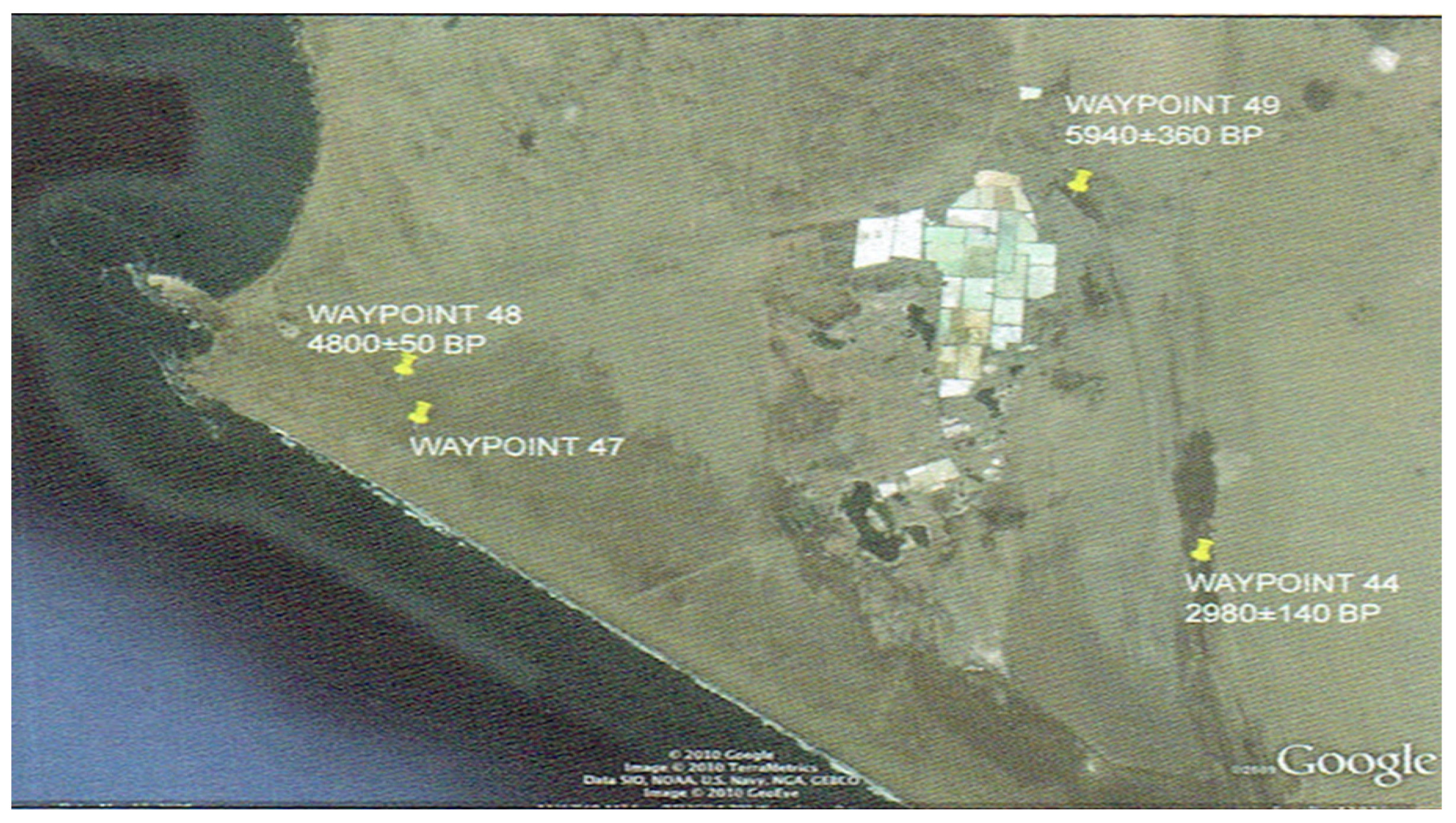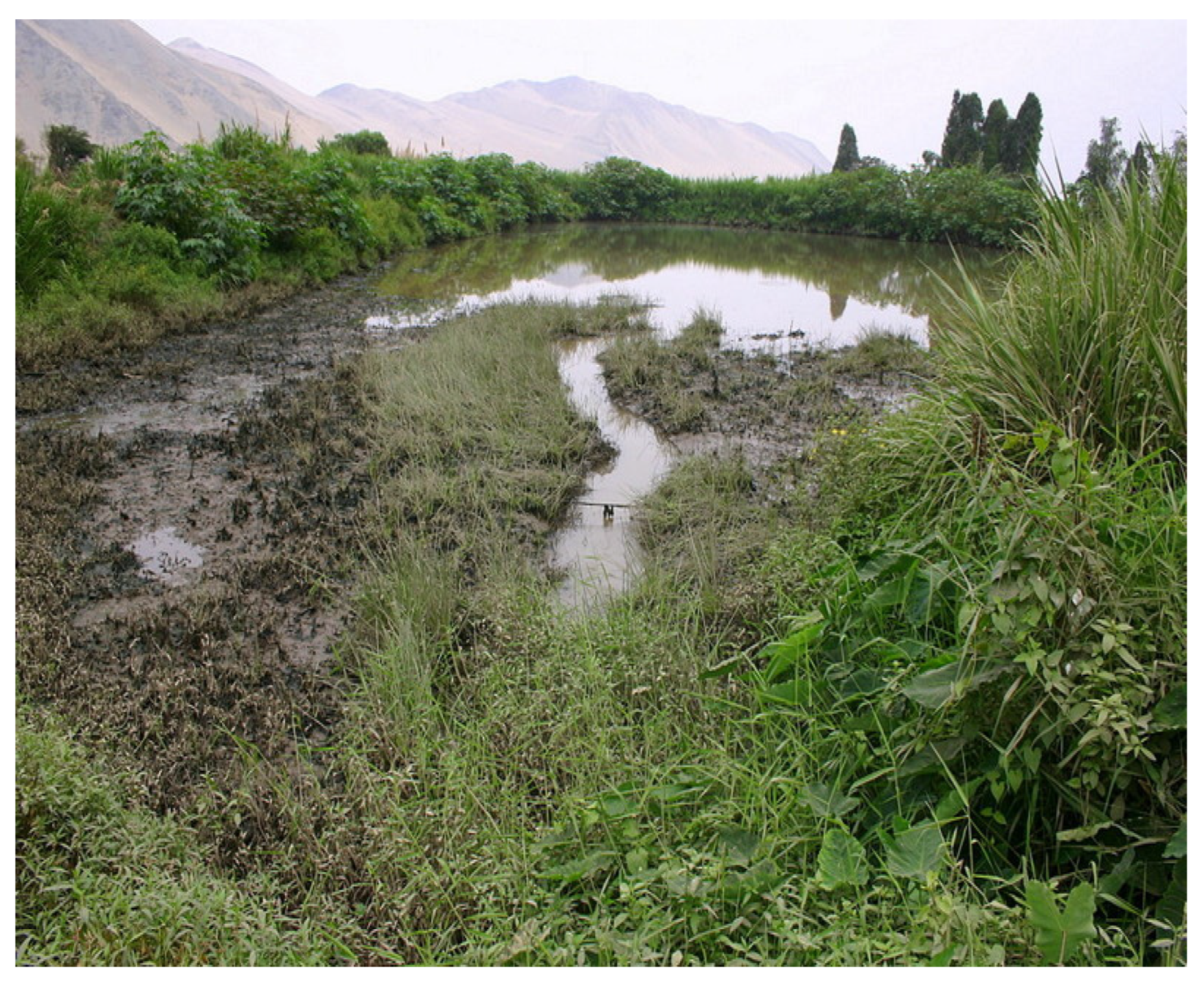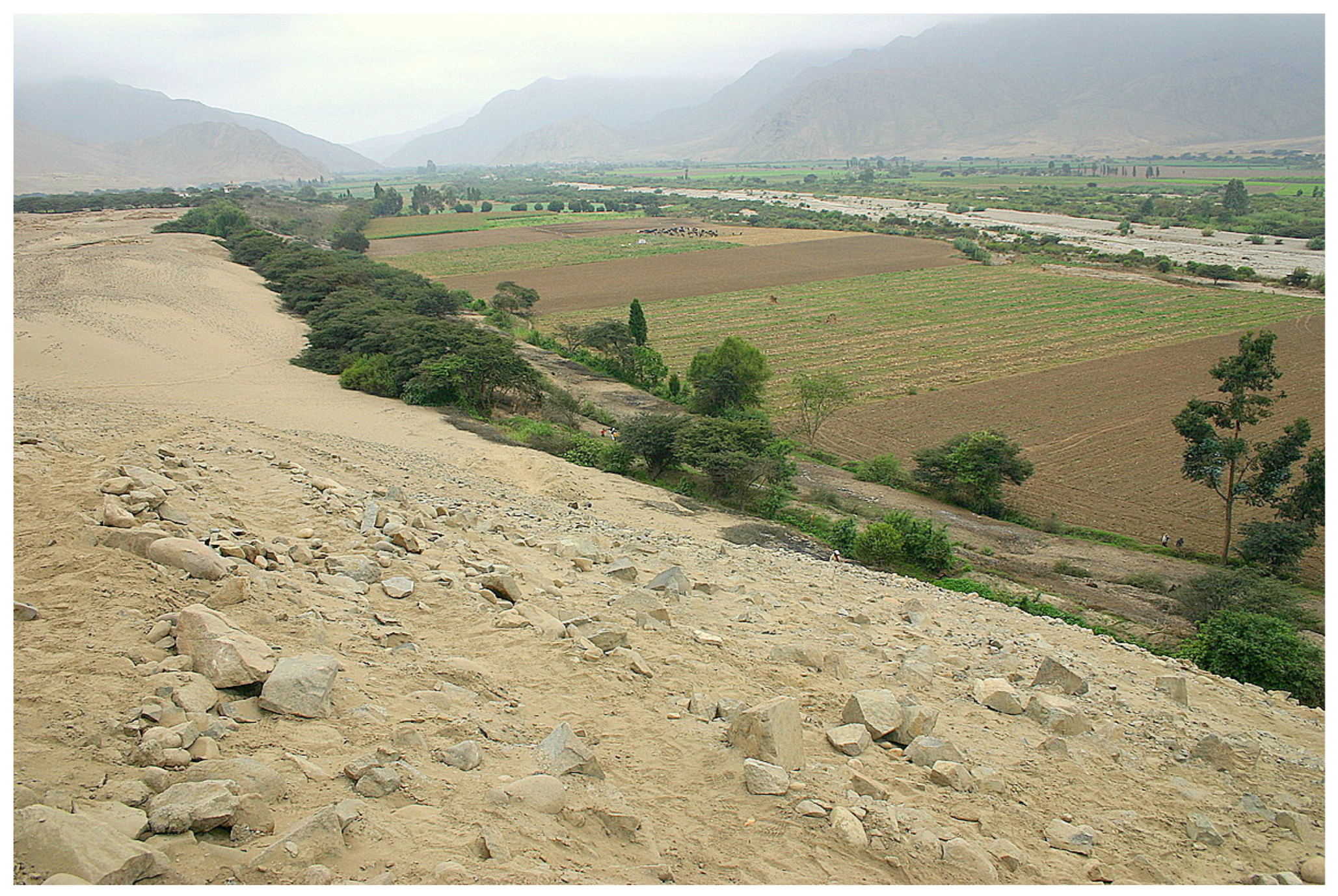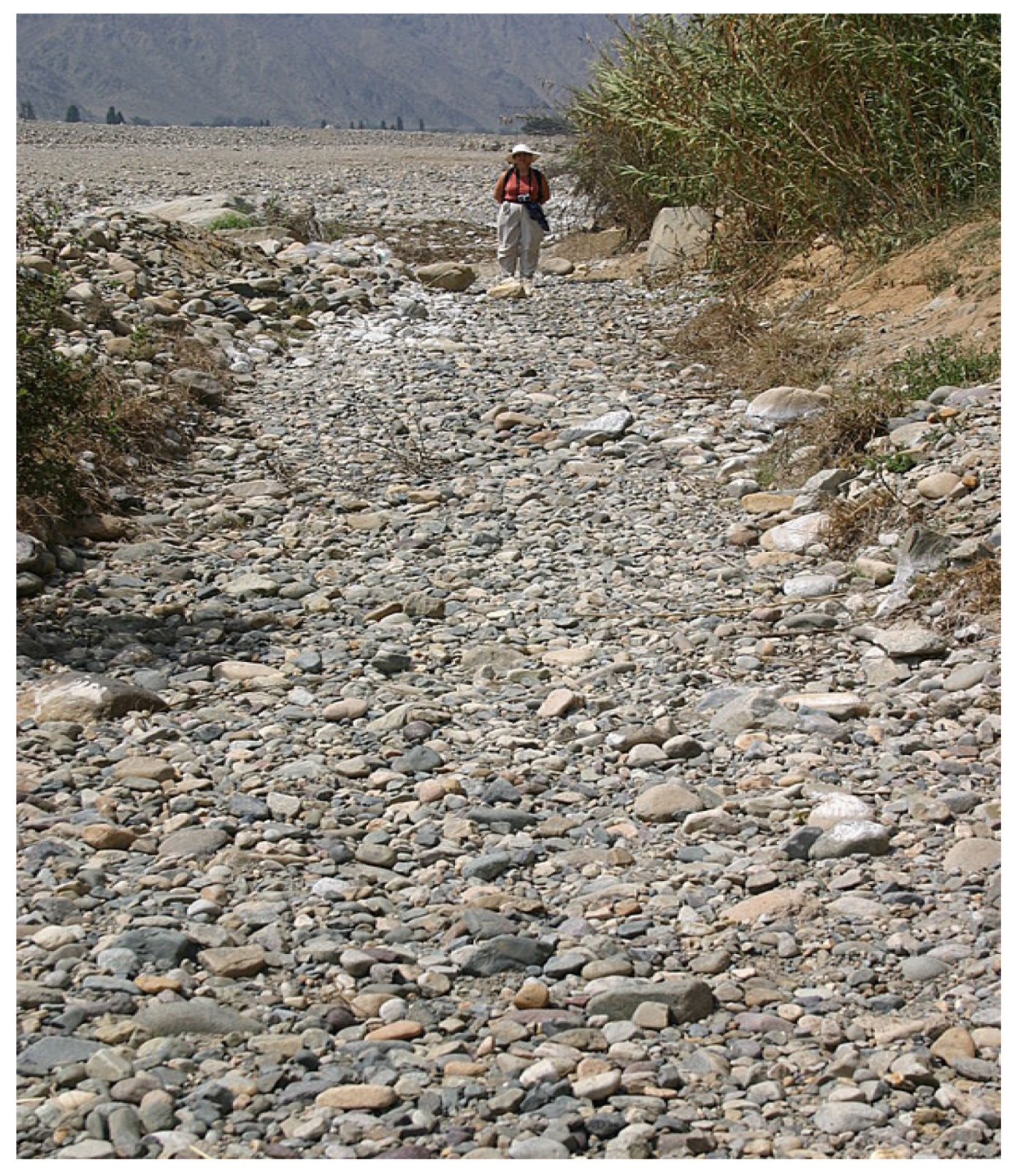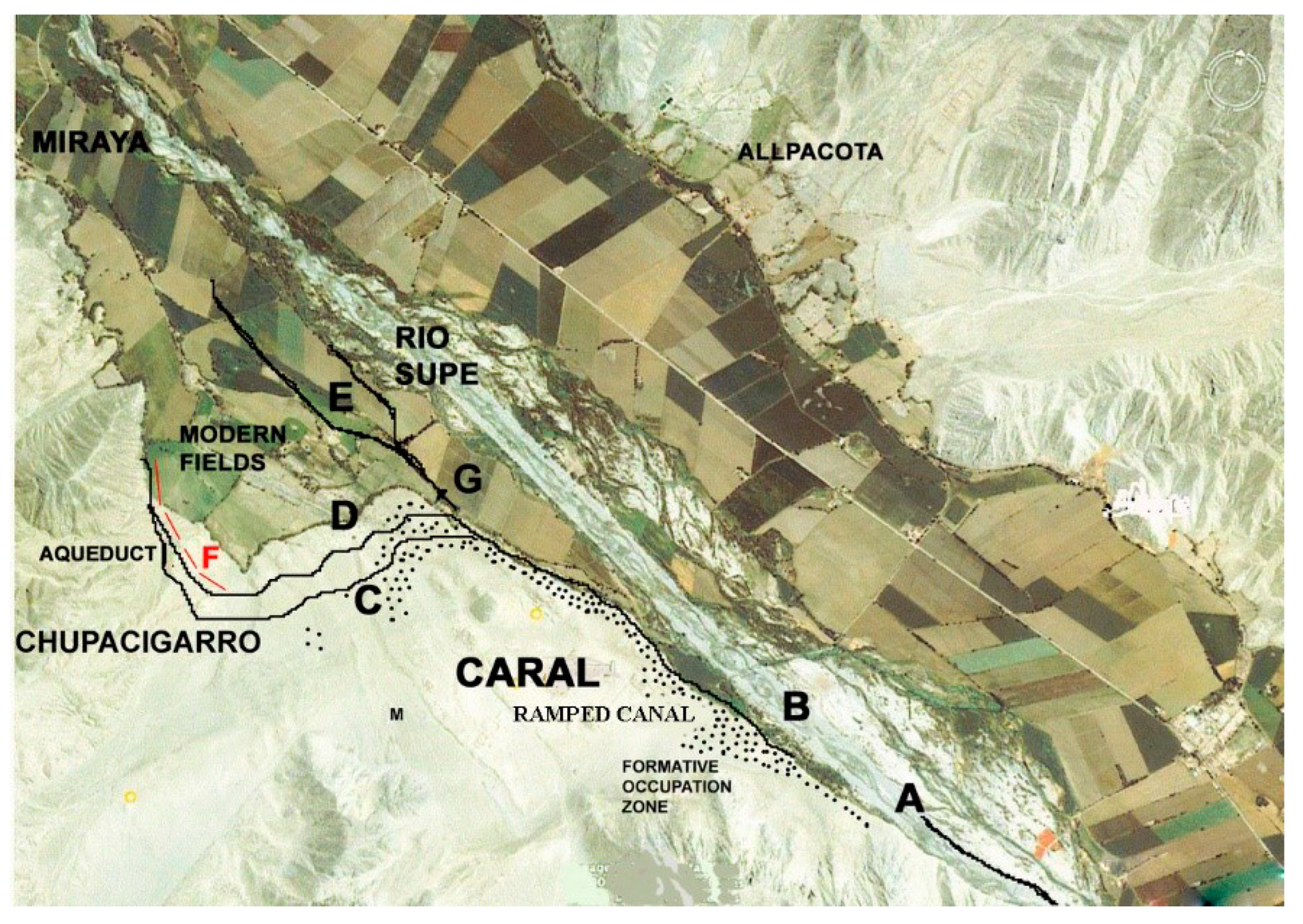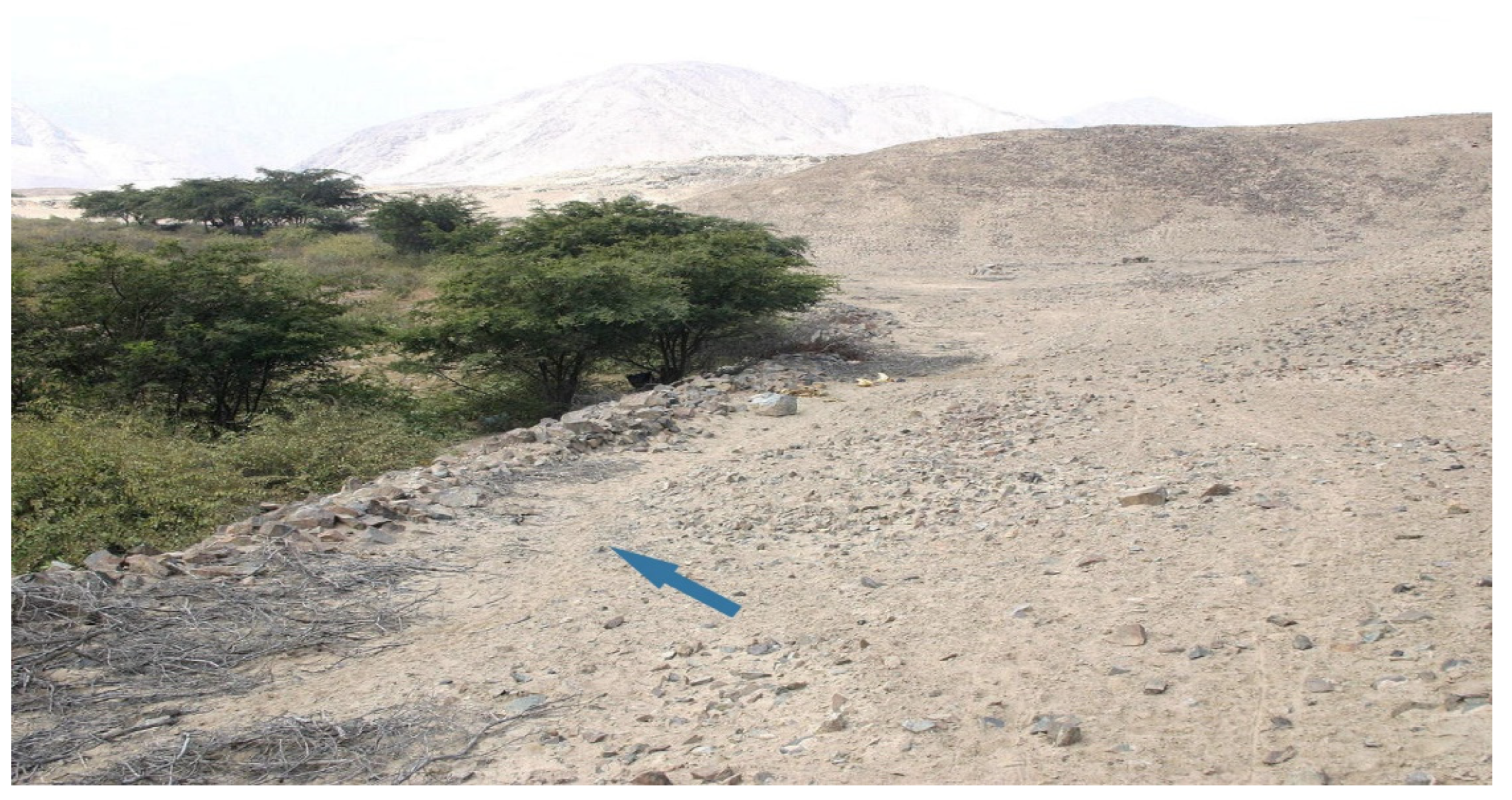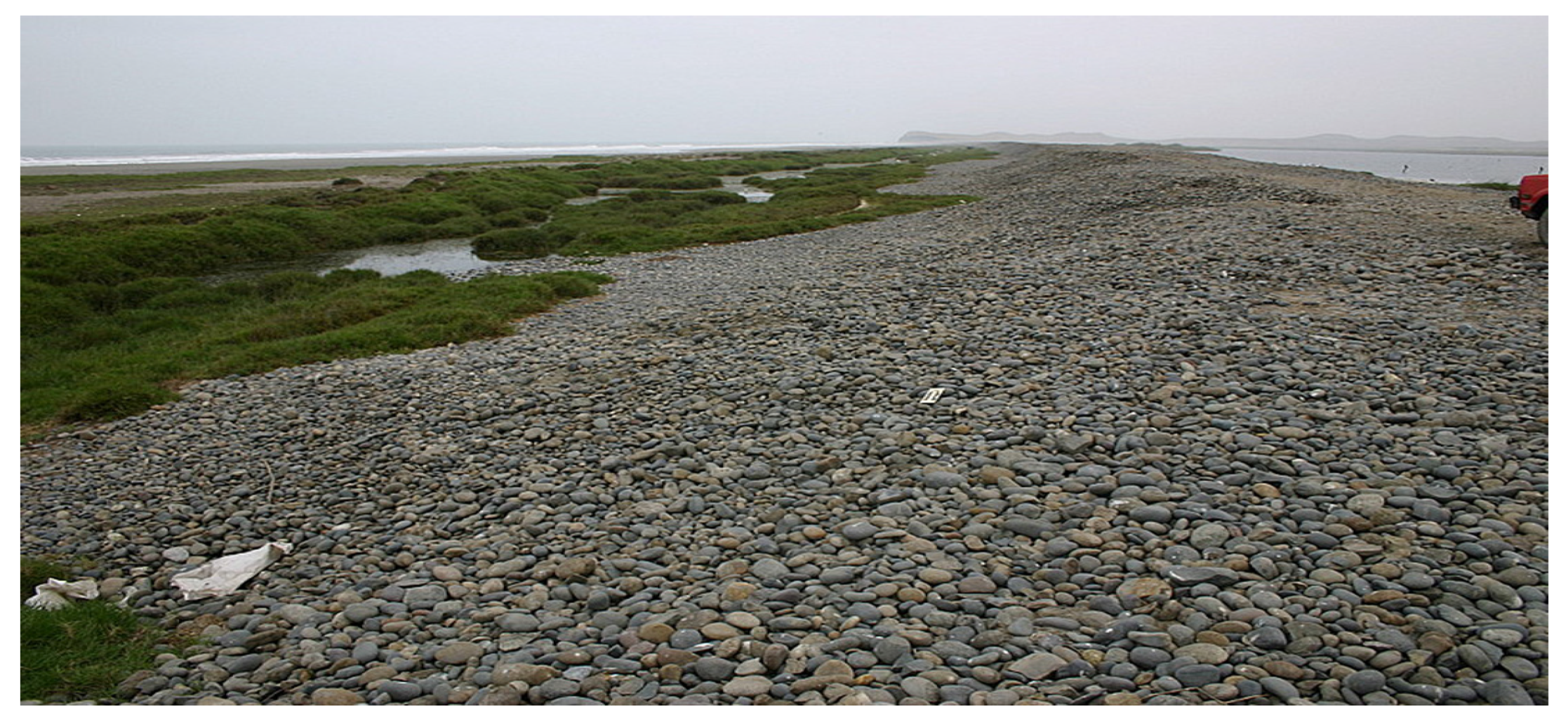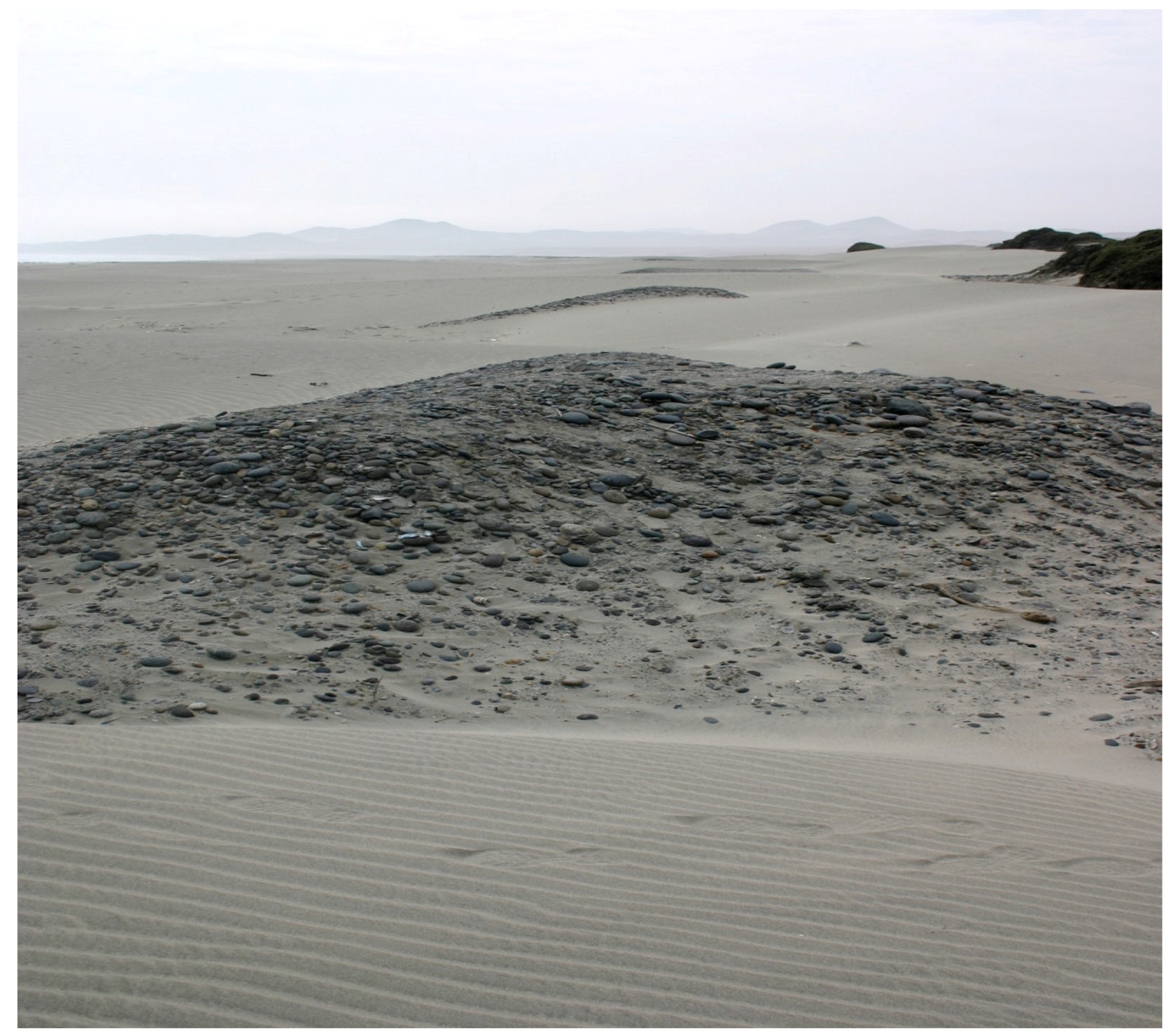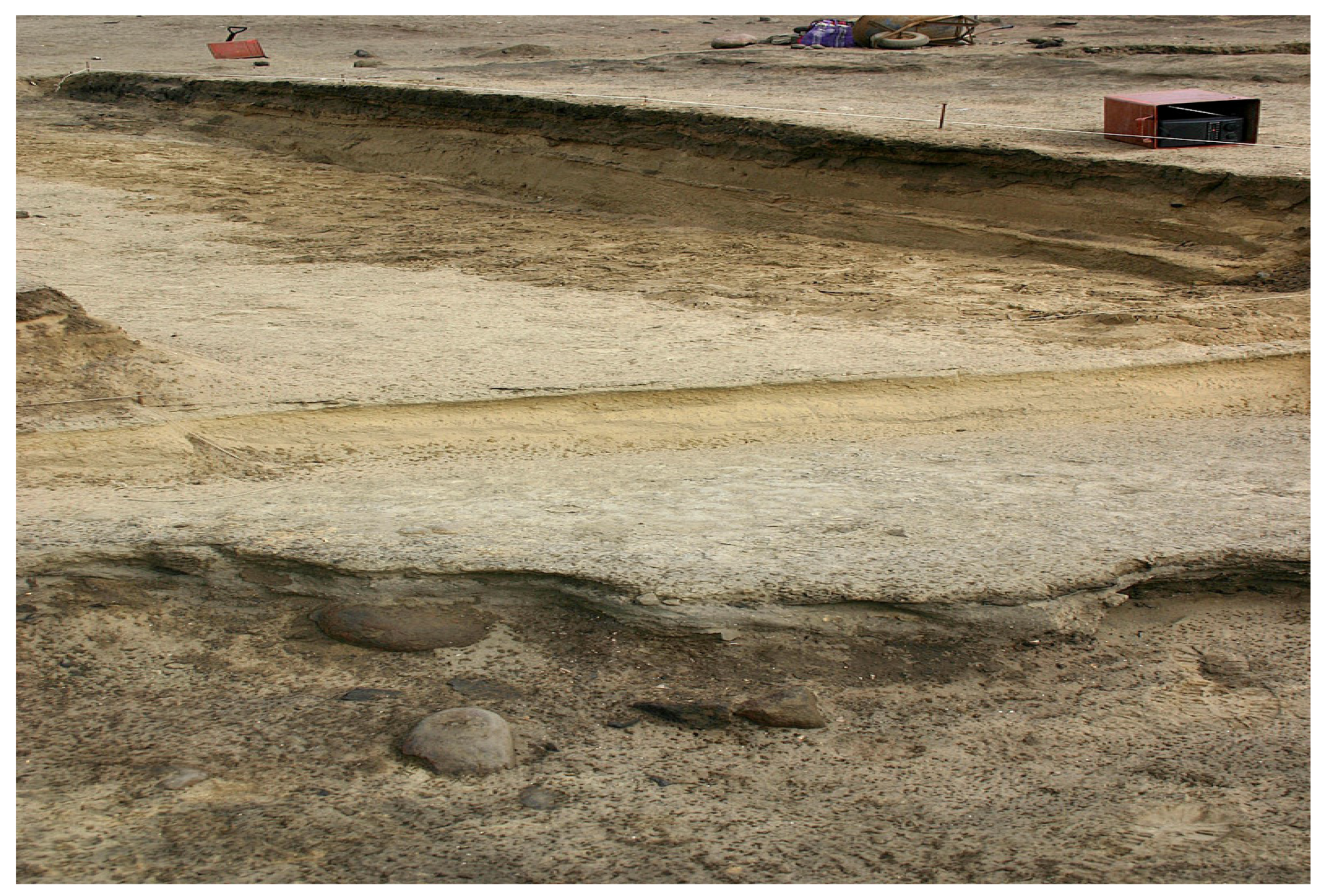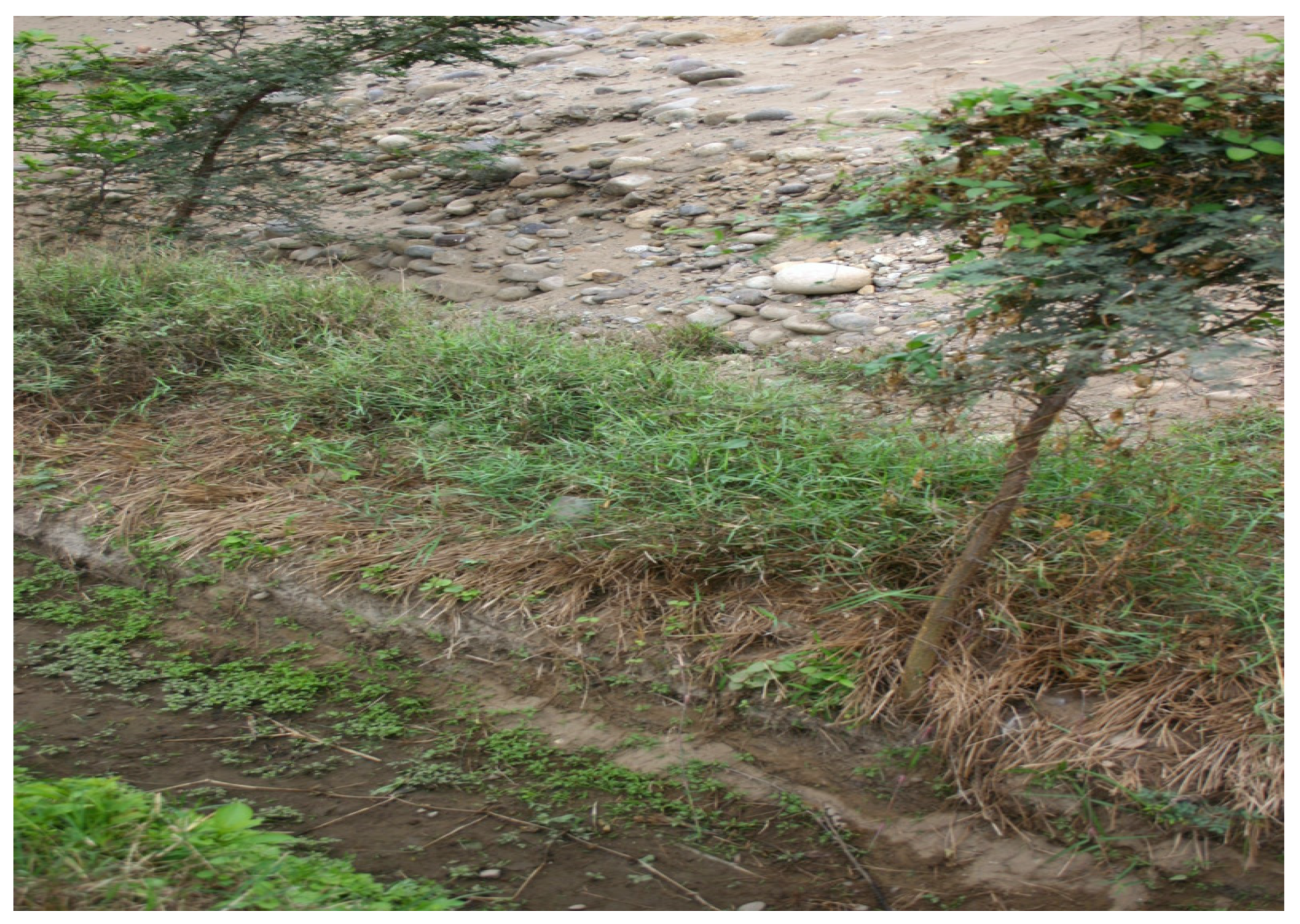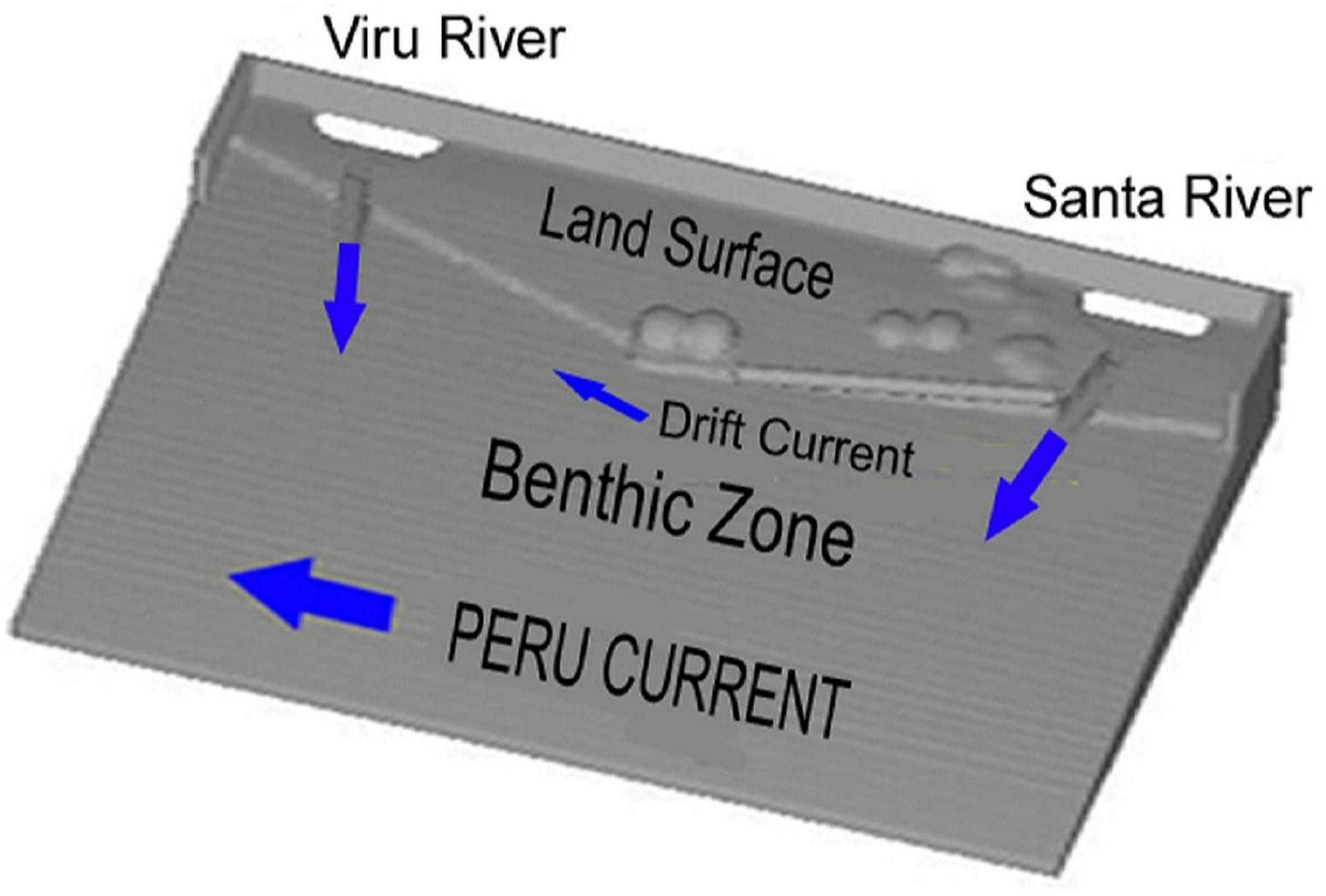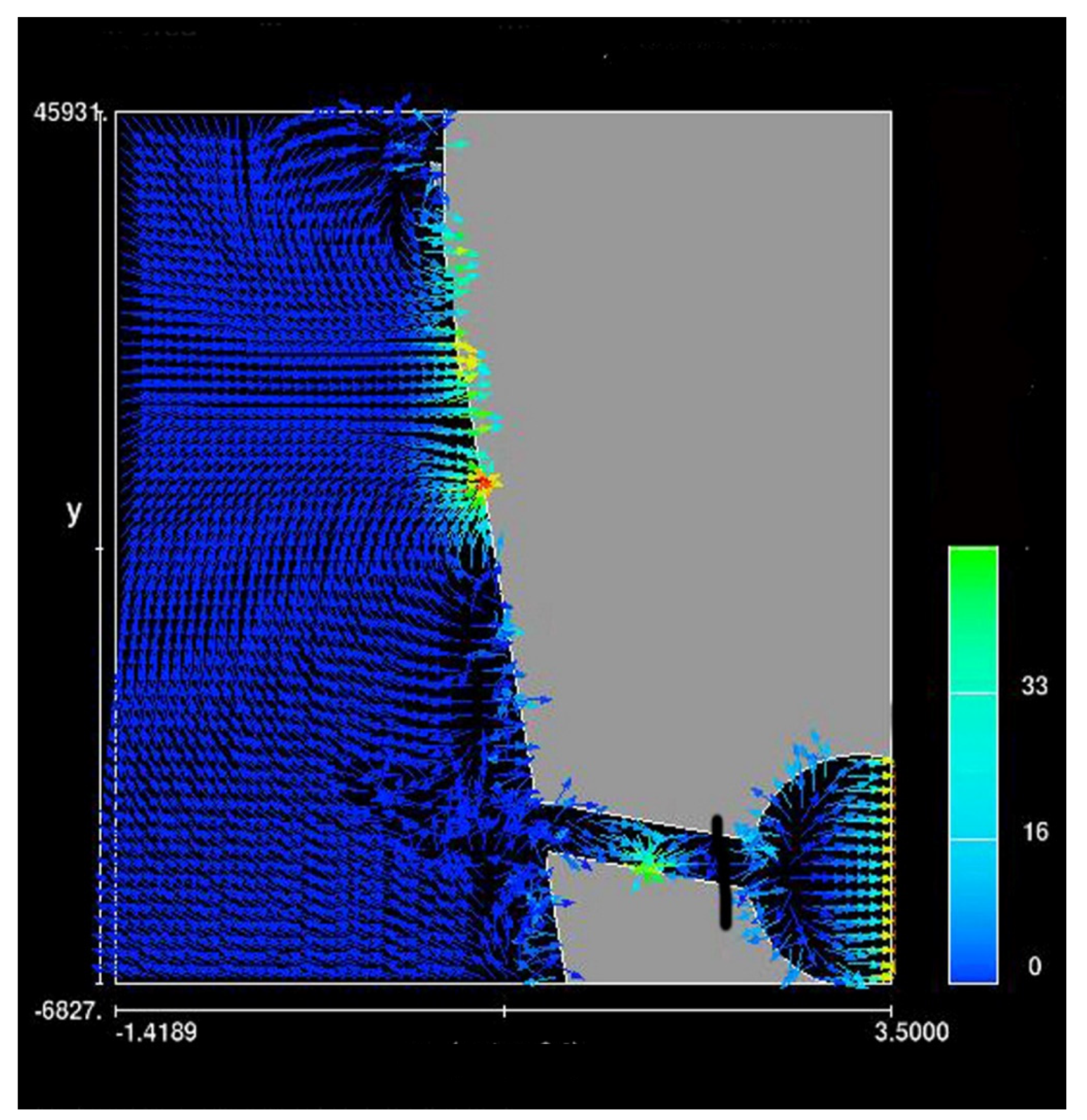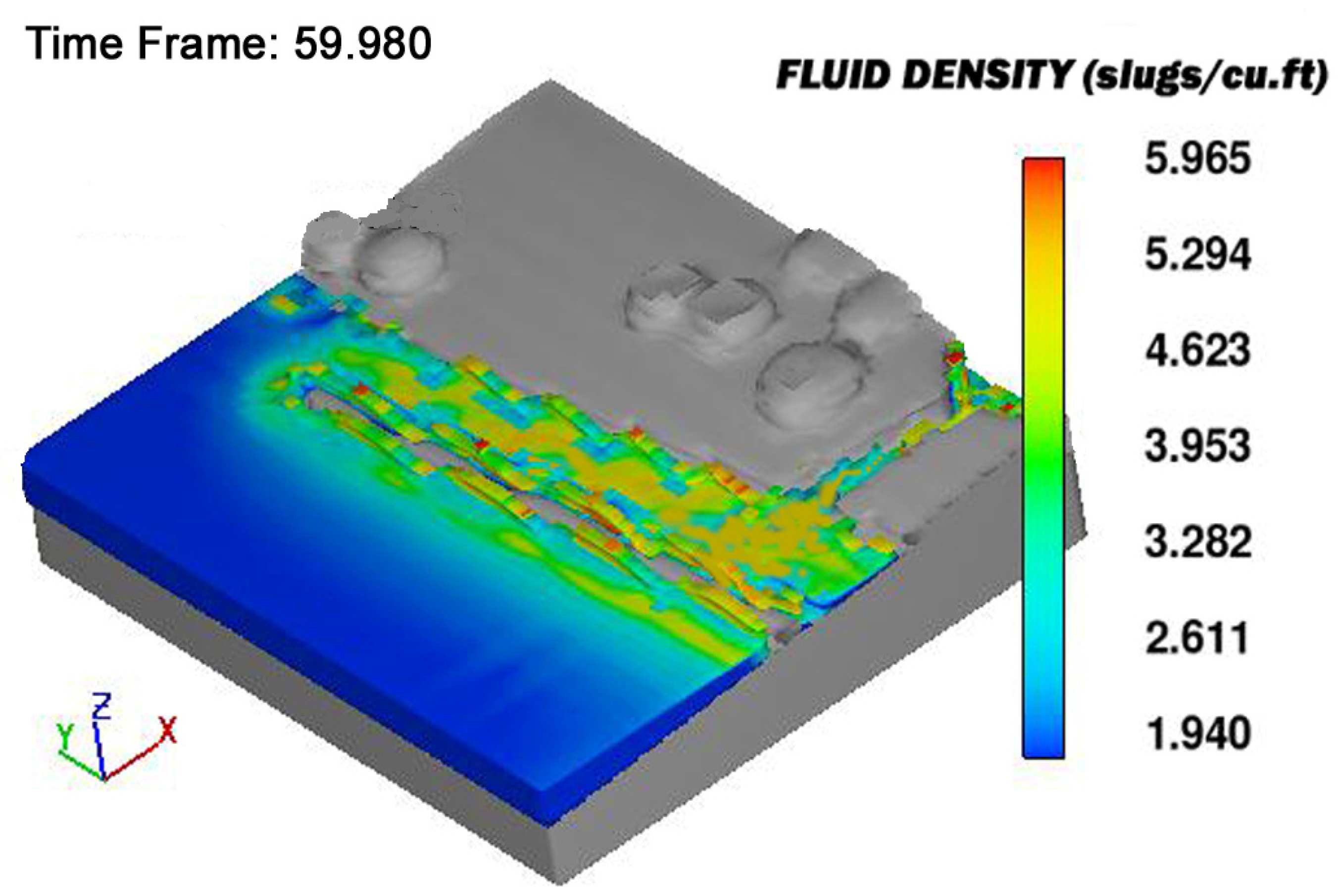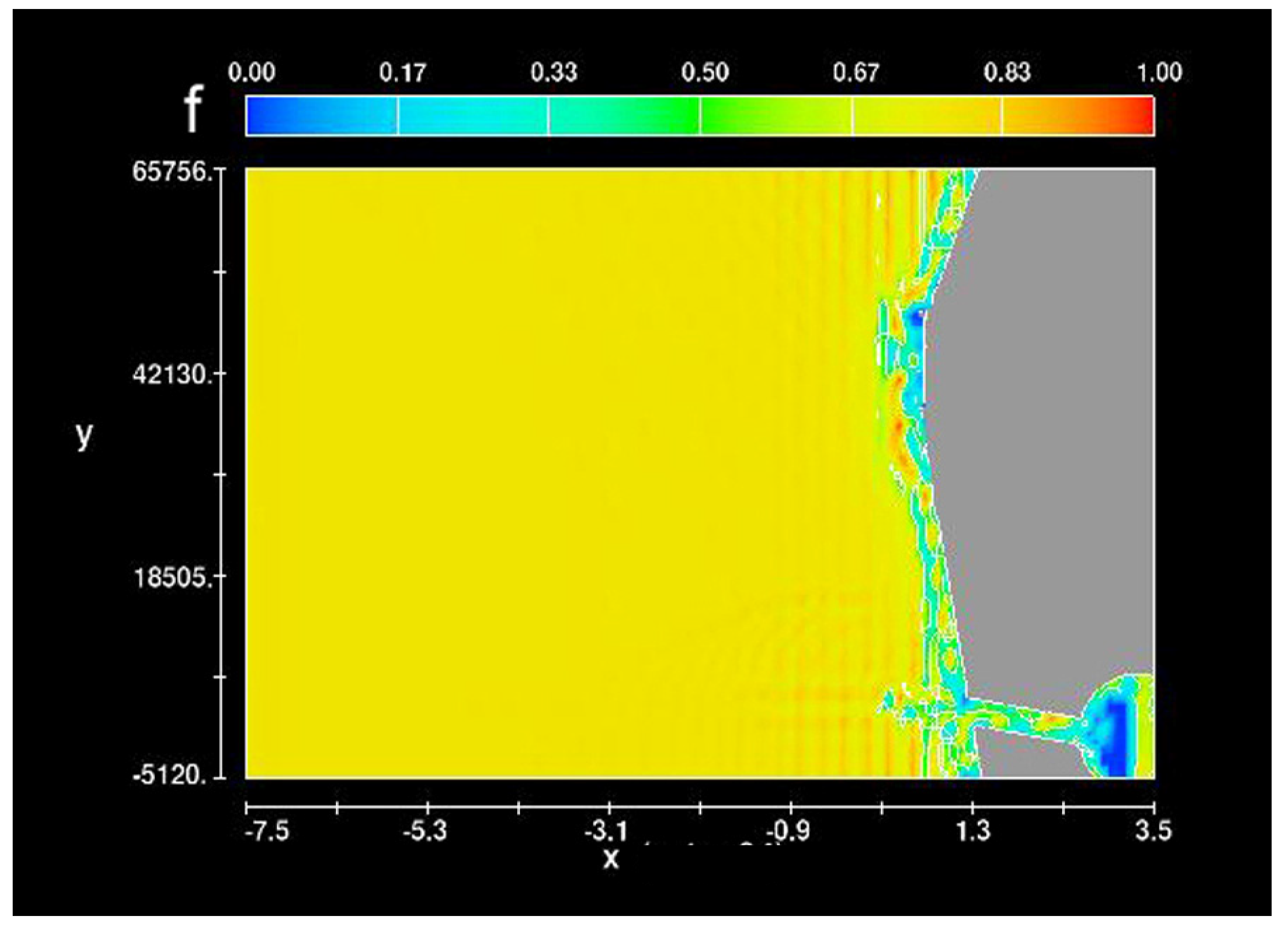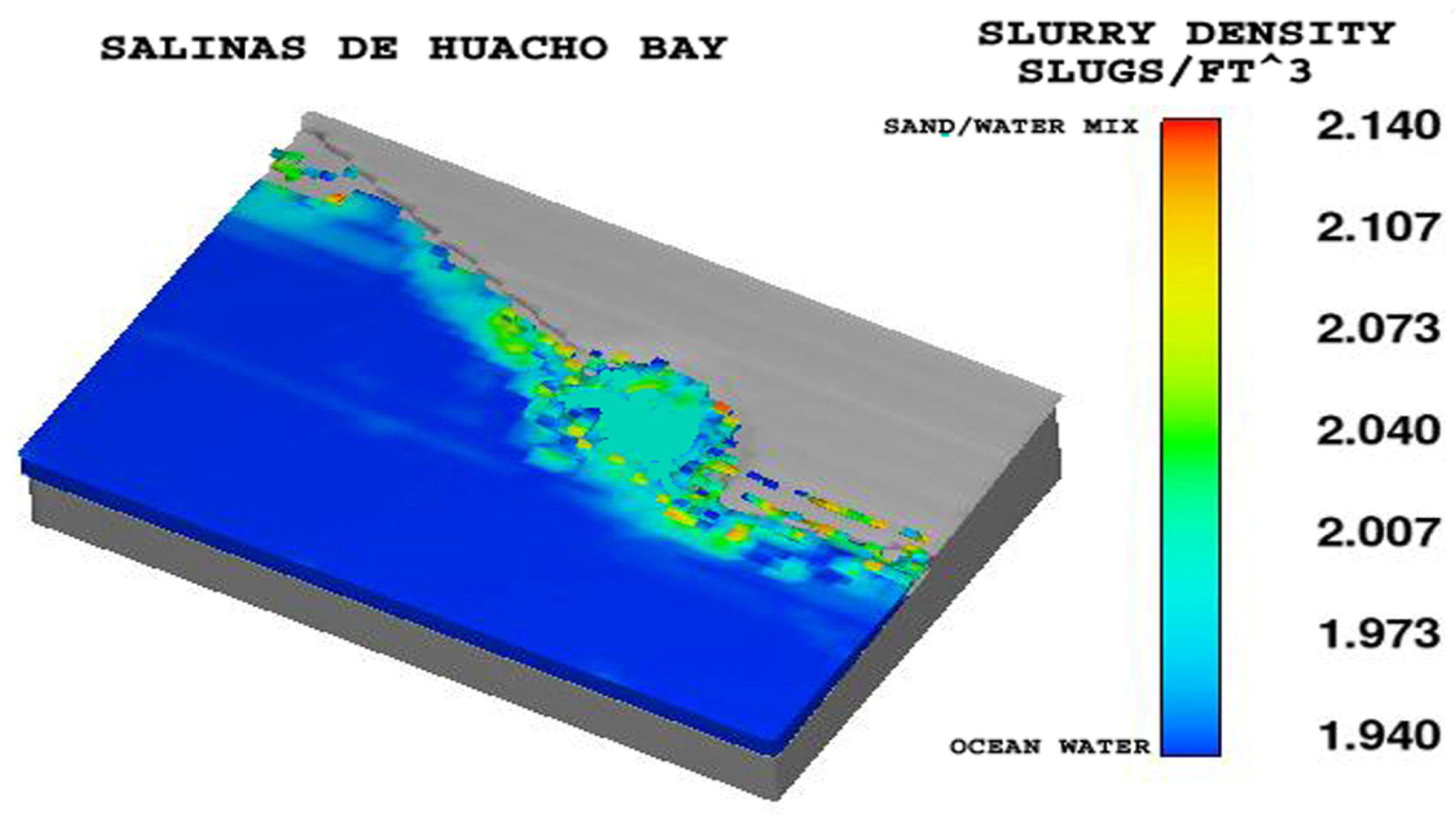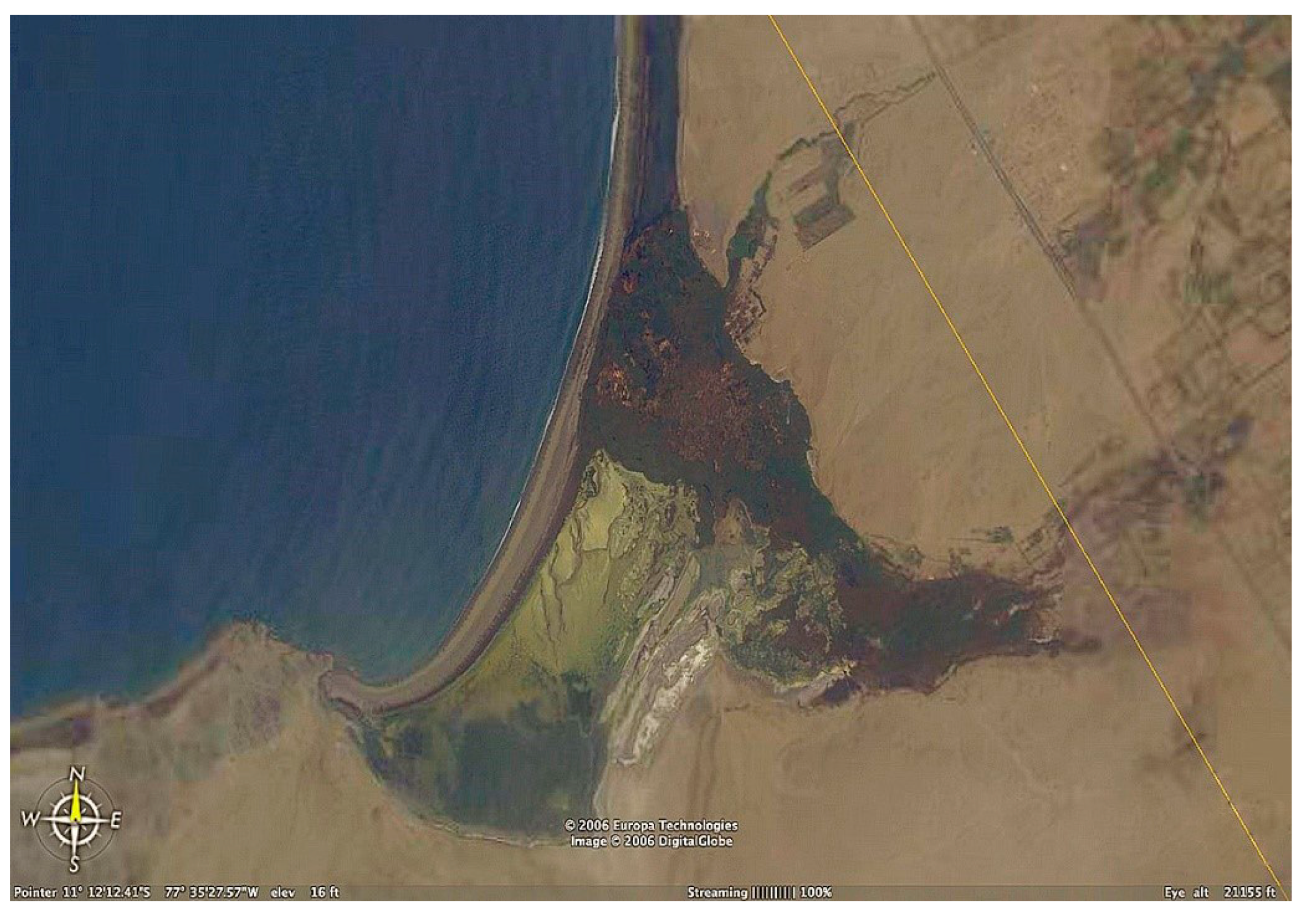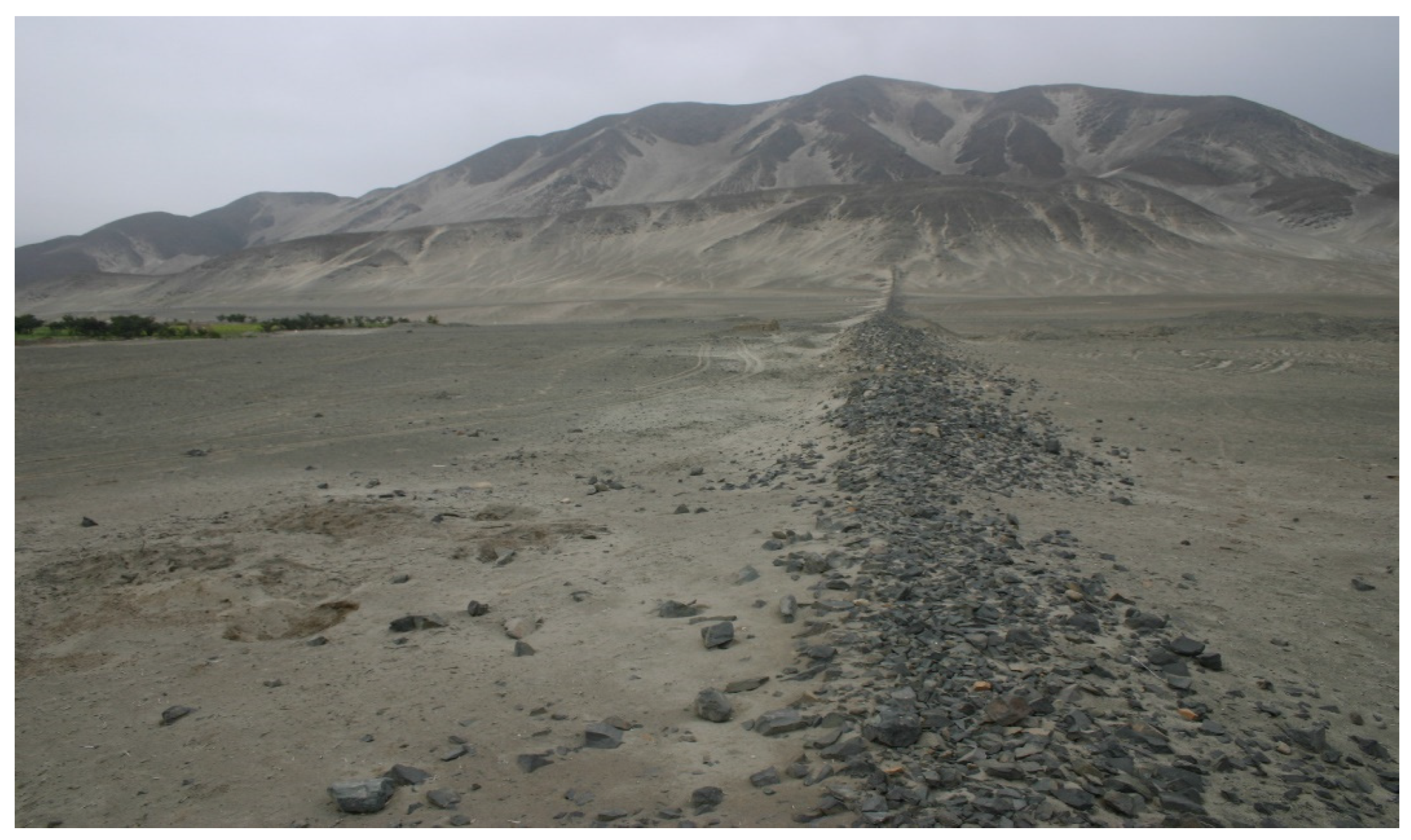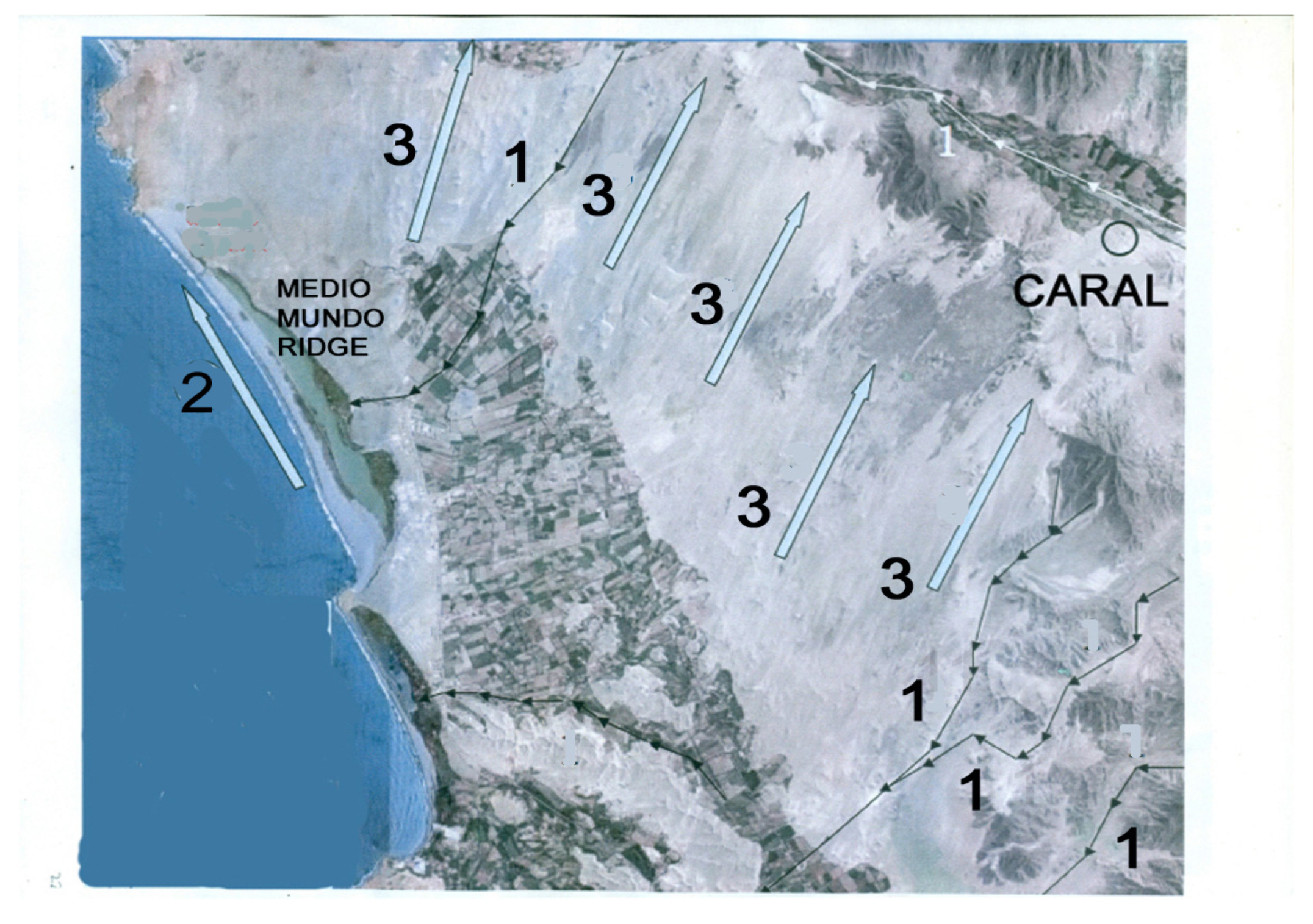2. Evolution of Late Archaic Sites in the Peruvian Supe Valley
The Late Archaic Period north central coast sites in Peru witnessed increased El Niño ENSO flood events that transferred flood sediments from coastal valleys into ocean currents forming a series of extensive beach ridges. The coastal beach ridges containing C14 datable material are therefore key to date major flood events. Typical interior valley landscape sediment layers and beach ridges resulting from datable multiple deposition/erosion events confirm the timing of major ENSO events, as well as intermediate stable climate periods that permit societal continuity and development between destructive ENSO events. As a result of the formation of multiple barrier beach ridges formed from a sequence of the ENSO flood events, the geophysical history of coastal littoral zones reveals that the river drainage to ocean currents was impeded, resulting in bay infilling and the development of coastal marshes behind the beach ridges. This, together with aeolian sand deposits that infilled agricultural land behind and in front of the beach ridges, compromised the productivity of food supply from agricultural lands. In ancient times (and continuing to present times), aeolian sand-dune incursion into the Supe Valley from constant northwesterly winds from exposed beach flats in valleys south of the Supe Valley compromised Supe Valley agricultural lands. Evidence of this transfer process in Late Archaic times is evident from datable sand layers containing organic material noted in excavation test pits. Thus, beach ridge formations and interior valley sand and flood slurry debris deposition layers from a series of the ENSO events datable to the end of the Late Archaic Period in the Supe Valley provide the basis for agricultural land shrinkage and the changes in the marine resource base that played a major role in the collapse of coastal and valley societies in the Late Archaic Period, as revealed in the subsequent chapters.
Many sites within the Supe Valley, with its ceremonial center at Caral, were based upon the trade of marine resources from coastal sites exchanged with agricultural products from valley interior sites [
8,
9,
10,
11,
12,
13,
14,
15,
16].
Figure 1 details the location of the major Archaic Period sites;
Figure 2 details the existence time of major Supe Valley sites while
Figure 3 provides the architectural details the Caral site. A probable, but no longer existing, inner city canal is implied from an excavated canal cross-section profile the existence of this early canal is subject of further research as Caral excavations proceed. ENSO landscape disturbances with no possibility of return to previous norms for the agricultural and marine resource of the Supe Valley society of 18 sites (
Figure 4) pose a probable reason for the valley site’s abandonment after ~1600 BC and indicate that the dynamic landscape change, as a result of the ENSO events, played a role in the collapse of Late Archaic Period sites in the Norte Chico region of Peru.
The Norte Chico region of Peru is characterized by many Preceramic sites (
Figure 1) with different existence dates (
Figure 2). Within the Supe Valley are many neighboring individual sites to central Caral (
Figure 3 and
Figure 4), characterized by complex social organization and urban centers with monumental architecture dominated by truncated, stone-faced pyramid structures of which Huaca Major is typical (
Figure 5). The T–T and W–W date band notations (
Figure 2) refer to a climate anomaly period [
17] influencing worldwide oceanic current shifts with probable influence on the frequency and intensity of El Niño events. As these changes occurred towards the end of the Late Archaic Period, some effect on the study areas may be inferred, but further research is needed to track their specificity to Pacific coastal areas.
The earliest Preceramic societies from the northcentral coast of Peru developed a cooperative economic model based on agricultural trade, irrigation agriculture, and the exploitation of marine resources to sustain large populations in the Late Archaic Period [
8]. The nearby sites associated with Caral in the Supe Valley formed a collective integrated societal complex (
Figure 4) participating in this exchange network. Coastal sites exploiting marine resources (fish, shellfish and edible seaweed types) traded with inland sites for agricultural and industrial crops, particularly cotton for fishing nets and lines, as well as gourds for net floats. In the Supe Valley alone, 18 sites (
Figure 4) evidenced the success of this economic exchange system [
8,
9,
10,
11,
12,
13,
14,
15,
16] over long time periods (
Figure 2), which experienced, and successfully survived, changes in environmental conditions brought about by Holocene sea level stabilization, Peru Current establishment and the increased frequency of El Niño flood events [
17,
18,
19]. Again, major flood events were the basis for sedimentary beach ridge deposits inducing river drainage blockage, the creation of coastal marshlands behind drainage barriers, valley water-table height elevation and changes and aggraded sand sea formation behind and in front of beach ridges subject to aeolian sand transport and deposition, all of which influenced the agricultural and marine resource base of valley and coastal sites. Despite these challenges to the food resource base, societal continuity prevailed through relocations of agricultural field systems from coastal to inner valley areas over long time periods; only when ENSO events reached a level of severity without options to continue the food supply base that was sufficient to supply an increasing population did the coastal societies experience a challenge to their continuance.
The beach ridge dates on the north central Peruvian coast and their locations are presented in
Figure 6. Note that most of the earliest north central coast beach ridges appear in the ~2000–1600 BC date range, an important period for major site landscape changes, as discussed in the following sections.
Strong coastal winds were the source of aeolian sand dune transfer to interior Supe Valley farming areas from the exposed beach flat areas, as noted by datable sand layers from the excavation pits. The aeolian sand transfer to interior Supe Valley areas originated from the vast sand seas in the Huara Valley south of the Supe Valley. Here, strong northwesterly winds carried sand across the low mountains separating the two valleys, to be deposited on the southern slopes and interior valley margins of the Supe Valley (
Figure 7); this effect continues to the present day. As the formation of a major beach ridge from a major ENSO event is noted in the Late Archaic Period record, this initiates a chain of events that threaten both the agricultural and marine resource bases of both coastal and interior valley sites.
As flood-induced sediment transfer into ocean currents and the formation of beach ridge deposits are fluid mechanics phenomena, recourse to CFD FLOW-3D techniques [
20] provide an insight into the sediment formation and deposition processes involved during major ENSO flood events.
To substantiate the CFD details of linear beach ridge formation, recourse to Google Earth satellite photographs of an actual linear beach ridge formation created after a recent major El Niño flood event in the Supe Valley and adjacent valley areas was apparent. The source of this new linear beach ridge on the north Peruvian coast within years after the large 1982 El Niño flood event then verifies that El Niño floods were the origin of a linear beach ridge formation over a relatively short time period. As beach ridge formation dates (
Figure 6) are contemporary with large flood sequences occurring in the Late Archaic Period, the CFD analysis provides the rationale that fluid dynamics govern their formation and the geometry behind their linear shape. The fact that later multiple ENSO events occurring after an original beach ridge deposition event may influence dating results through deposition/removal of datable organic material is considered in
Figure 6 to provide the mean and one sigma deviation band for an original deposition event. As a major El Niño event leads to a singular deposition ridge, the time sequence of sequential deposition events and the El Niño flood event that caused them can then be determined.
Coastal progradation stemming from sediment accumulation behind the barrier beach ridges is demonstrated by the C14 dating of different mollusk species known to occupy different shallow-water depths; when different mollusk species are found far inland, this indicates the coastline existing at that datable time (Daniel Sandweiss, personal communication).
Figure 8 provides an example of shoreline littoral change over time related to the ENSO-induced events, as indicated by the dates associated with waypoint test pits.
The geophysical landscape changes affecting the agricultural and marine resource base of Late Archaic societies played a catalytic role in the fate of many Late Archaic Period sites. While research continues into the social, political and economic structure of Late Archaic Period sites and their response to climate change environmental stress to determine the details of societal structure modification [
21,
22,
23,
24,
25,
26,
27,
28], the present discussion focuses on the underlying fluid dynamics of beach ridge formation and the consequences of induced geophysical changes by flood and aeolian sand transfer events that affected the agricultural and marine resource base of Late Archaic Period sites.
7. Geophysical Origins of Beach Ridge Formation
Various types of beach ridges observed at different locations along the Peruvian coastline (
Figure 17 and
Figure 18) result from the complex interaction of river-borne El Niño flood sediments with oceanic and wave action currents to produce beach ridge sequences.
Figure 19 and
Figure 20 illustrate inland deposition layers originating from the same events.
Post-sea-level stabilization, sediments and aeolian sand transfer began to accumulate west of the Quaternary sea cliff that marks the back of the original Supe Bay and the smaller Albufero and Medio Mundo inlets to the south and the Paraiso Bay, south of Huacho. In time, narrow beach ridges developed from a series of ENSO events inducing sand accumulation behind each ridge; this period was followed by stable progradation that buried each minor ridge by aeolian sand transfer and dune formation. In about ~1800 BC, a major ENSO event created the large Medio Mundo beach ridge along ~114 km of coastline sealing off former fishing and shellfish gathering bays. This event created large scale sand flats that accumulated behind beach ridges and promoted the large-scale aeolian sand dune inundation of coastal plains and inland valley areas compromising a significant part of the agricultural base of the Supe Valley society. The coastline geomorphic change affecting the marine resource base of Norte Chico societies was affected by a combination of flood sediment accumulations amplified by aeolian sand transfer processes that infilled previously established fishing and shellfish gathering areas. Although river-borne sediment constitutes a major source of slurry transport during flood events, additional opportunistic drainage paths originate from areas between river valleys to provide addition sediments to ocean currents. Again, many north central coast preceramic sites terminated occupation by ~1800 BC, suggesting that a major geophysical change over a wide coastal area compromised their economic base, thus, the importance of understanding the geophysics of beach ridge formation and its consequences on the agricultural base of archaic societies. The abandonment of major preceramic sites, with limited Formative Period reoccupation of a limited number of former sites, motivates the discussion to follow as to what these changes were to the economic base of archaic societies and their relation to beach ridge formation.
Tectonic coastal uplift rate differences from north to south latitudes influence beach ridge typology. A significant uplift rate may strand and separate sequent ridges from individual flood events, while, in the absence of uplift, single subsea ridges form and sediment deposits accreting landward from the ridge appear to strand a ridge above the land/water interface. Additionally, offshore undersea ridge formation may alter the deposition history of subsequent later ridges by altering seabed shape, river mouth geometry and river positional shifts. Later flood events may also erode and erase previously deposited ridges, and aeolian sand incursion may bury segments of earlier ridges; all these factors, operational over millennia, influence the remains of ridges. The relation between flood events, beach ridge formation and agricultural landscape change, as demonstrated by CFD computer-modeling results, are subsequently detailed to illustrate their connectivity to provide the basis for conclusions supporting the observed geophysical transformations of Supe Valley agricultural and littoral areas in Late Archaic times.
To illustrate the fluid mechanics basis of ridge formation, a three-dimensional computer model of the Peruvian coast from Santa to Viru Valleys was created (
Figure 21) using FLOW-3D software [
20]. The minor intermediate Chao Valley drainage between the Santa and Viru Valleys was omitted from the CFD model, due to its minor effect on the beach ridge formation compared to the major Santa and Viru river drainages. The intent of the CFD calculations are to show the fluid mechanics transformation of flood slurry movement into ocean currents during an El Niño event that can produce an extensive linear beach ridge; this linear beach ridge formation is unexpected and, intuitively, one may not associate a chaotic flood event and chaotic slurry transport into ocean currents as the source producing a linear beach ridge structure.
The use of a CFD model is made to demonstrate how fluid dynamics can duplicate observed geophysical events that occur during a major El Niño flood event. Details from the CFD analysis can uncover the geophysics behind field observations and help to understand nature’s role in the formation of deposition and erosive landscape structures observed in field studies. The CFD model area in
Figure 21 was selected due the availability of data [
4,
6,
7] in the Santa-Viru coastal zone that allows for the qualitative verification of modeling results compared to field observations. It is expected that the CFD results obtained on beach ridge formation in the Santa–Viru coastal area are qualitatively similar to the ridge development in the nearby Supe Valley coastal area, given that the same fluid mechanics-based geophysics applies. Shown in the
Figure 21 CFD model are the sloped offshore seabed and coastal land areas, with southern Santa and northern Viru River Valleys providing known data as to beach ridge formation from an El Niño flood event where sediment conduits to the ocean current are the source of beach ridge formation. During a major flood event, slurry material from the eroding landscape is transported into local rivers and conducted into ocean currents. The interactive geophysics of the slurry interaction with ocean currents and the settling of the slurry to form a beach ridge is then predicted by CFD analysis. Inherent to the CFD analysis are the details of the formation of landscape change from erosion/deposition events as well as beach ridge formation processes; while field observations only record the results of flood events, CFD analysis provides the fluid dynamics mechanisms behind their creation.
The composition of flood-transported slurry material is drawn from the size, gradation, cohesivity and stratification of erodible bank sediments over the coast-to-mountain area watershed and surface material washed into the streambed. Profiling a selection of beach ridge cores provided an indication of the percentage by weight of different-sized sediment particles. High concentrations of large-sized particles (gravel and small boulders) in the wash load damp slurry turbulence, increase the apparent viscosity of the slurry flow and reduce their settling slurry velocity, enabling the early settlement of coarser grains and a larger bed-material load compared to finer grade slurry material. While only river-borne sediment transfer is considered for CFD model purposes, additional opportunistic drainage channels and ephemeral streams develop during flood events, leading to sediment transfer to lower coastal areas that contribute additional sediment to ridge formation/accretion processes and landscape change.
A two-fluid CFD model represents slurry sediment–ocean mixing interaction. Fluid 1 is ocean water characterized by kinematic viscosity ν1 and density ρ1; Fluid 2 is sediment-laden flood water slurry characterized by high values of kinematic viscosity ν2 and density ρ2 compared to ocean water. Here, ν = μ/ρ, where μ is the absolute viscosity. Depending on the sediment load of the floodwater, ν2/ν1 can range from 1 (no river-borne flood sediment) to 103 (heavy river-borne sediment loads with very high absolute viscosity).
For purposes of demonstrating the fluid dynamics phenomena involved, a selection of input properties typical of observed sediment composition is presented. Due to local variations in sediment composition, only a generic, illustrative slurry composition is presented that is typical of the conditions in the area of study. Model river-current velocity is set to a value to induce riverbed erosion and sediment transport mobility. For silt (<0.001 mm diameter, ~15% by weight), sand (0.1 mm diameter, ~30% by weight), gravel (0.1 to 5 mm diameter, ~35% by weight) and an assortment of rock-particle sizes (5 mm to 100 mm diameter, ~20% by weight) composing the sediment solids, estimates of both properties and critical mobility stress levels are provided by [
2,
38,
39,
40,
41,
42] to substantiate the typical υ
2/υ
1 values used in the CFD simulation. The northward offshore current velocity is set low to represent near cessation during El Niño events. A near-shoreline, northward drift current is induced from the difference between the incoming wave vector angle and a normal vector to the shoreline. The model sea level is set to the stabilized ~5000 BC level. By using model length scales (model area is ~1035 km
2) and slurry velocity ranges approximating actual values, Reynolds and Froude numbers are duplicated, and the computer time is equal to the real beach ridge formation time. The results provide a lower-bound time to determine the flood duration required to deposit beach ridges of known sizes and volumes. Note that the early Quaternary version of the shoreline consisted of deep river-downcut bays consistent with the lower sea level, and that wave-cut bluffs (now inland from the present-day accreted shoreline) resulted from rising sea levels, the subsequent deposition of sediment over millennia is from floods, river, and aeolian sand transport that served to infill this landscape. The present computer model is qualitatively representative of an intermediate stage in this landscape transition process during a flood event. The results of the CFD computations then represent the early stage of beach ridge formation: subsequent millennia of accretion and erosive effects then serve to represent current day observed shoreline patterns.
The results of Santa–Viru coastal zone simulation are subsequently summarized. This zone has a well-documented ridge sequence [
4,
6,
7] and is used to test computer predictions with observed geomorphic features that have survived from early creation stages to present-day stages.
Figure 22 shows the initial offshore sediment deposition density distribution from a single, large El Niño flood pulse concentrated in the Santa–Viru Valley area; the density scale ranges from 1.94 slugs/ft
3 (1000 kg/m
3) for seawater to 5.40 slugs/ft
3 (2783 kg/m
3) for heavy flood slurry. For a lower-limit slurry grain size of 0.01 mm, erosion, transport and entrainment are maintained from 0.001 to >10 m/s velocity; for a grain size of 10–100 mm, erosion, transport and entrainment are maintained for >1.0 m/s velocity [
2,
42]. On this basis, a river near-surface velocity is assumed to be ~1.0 m/s, for purposes of demonstrating the sediment–ocean current mixing and deposition process by CFD simulation. Since slurries of the type encountered in flood debris are highly non-Newtonian power law fluids, shear thickening with an increasing shear rate is expected. Here, a higher apparent viscosity applies, and the kinematic viscosity proposed is used for purposes of the demonstration problem. An observation made of highly viscous slurry motion in river valleys during the catastrophic El Niño flood event in 1982 during my stay on the Peruvian north coast gives credence to the slow slurry velocity used in CFD calculations. Although the velocity profile for Newtonian, viscous channel flow can vary from that determined for non-Newtonian slurries [
40], for the present demonstration problem, the slurry is assumed to have a constant absolute viscosity, rather than a shear rate dependent value. The offshore Peru Current velocity is approximated to be ~5 cm/s and the coastal drift current is ~3–5 cm/s, with local drift velocity values computed based upon the geometry of the coastline (Daniel Sandweiss, personal communication). The elapsed time is ~35 hour of continuous El Niño flood activity, with ν
2/ν
1 = 10
3 indicating a high absolute viscosity, heavy sediment load carried by the flood currents. The offshore average seabed slope is ~0.15° from horizontal for the Santa–Viru north central coast area; the offshore seabed slopes after 3800 BC are estimated from Barrera [
35]
Figure 11 and Pulgar Vidal [
40], as well as the values for oceanic current velocity.
Figure 22 indicates the formation of a long sediment deposit beach ridge on the coastline; the scale shades represent the mixture density of seawater and the initial flood slurry density emanating from the rivers. Notable is the early deposit of (green) heavy materials and the further offshore deposit of lighter (yellow-orange) slurry component materials. The northward current, together with the near-shore drift current, enhances the northward deposition of the sediment. The predicted high density, larger size sediment compositions appear along the ridge length, as observed from field studies [
4], while the transport and sorting of sediment fines continues in time from wave-induced drift currents. For steeper seabed angles, the formation of a close-in ridge deposit to the shoreline occurs; here, a steeper seabed angle results in a greater sea depth closer to the shoreline and, as resistance to a sediment particle’s forward motion is related to the hydrostatic pressure encountered on its front projected area (in addition to viscous drag and dynamic pressure effects), sediment deposition occurs more rapidly for steeper benthic seabed angles.
A velocity vector plot (
Figure 23) shows that the out-rushing sediment stream creates a flow reversal pattern when encountering ocean and shoreline currents, leading to deposits of lighter sediments back towards the shoreline where low drift velocities prevail. The ‘U-turn’ of the sediment stream is consistent with the path of least resistance of small and intermediate sizes, low-inertia sediment particles that alter the direction away from the increased hydrostatic pressure resistance encountered further from the shoreline. As offshore Peru and drift current directions are not aligned, the agitation and transport of the deposited fines cause a gradual northward ridge extension over time. Of interest is the disturbance of the ocean current both near and far offshore by the river borne slurry injection as well as currents that show northward flows from the river mouth that influence sediment deposition far north of the river mouth. The CFD calculation results provide a qualitative relation between an El Niño flood event and details of ridge formation: floods with large sediment loads can produce extensive near-shoreline subsea deposits whose size depends upon flood duration and amount/type of sediment available for transport by ocean and drift currents.
For
Figure 22, the density of the slurry stream is 5.2 times that of ocean water. Many beach ridges observed in the Santa–Viru sequence are composite, indicating large accumulations from multiple, closely-spaced-in-time flood events; where aggraded sediment material separates ridges, a longer time interval had occurred between major flood events: the use of C14 dating on organic material within the ridges then present the dating of ENSO flood events. Beach ridges contain mollusk shell material indicative of seabed sediments being agitated and entrained during flood events. Once the ridges are stranded on land by surrounding aggraded material, later flood events create new subsea deposits that accrete material to create the ridge sequence noted in the Santa–Viru coastal area, where shallow seabed angles prevail (
Figure 23 and
Figure 24 illustrates this occurrence). South of this zone, where steeper seabed angles prevail, a composite, a unitary ridge type is predicted. Situations occur in which loose surface sediment is minimal and/or the surface runoff water velocity too low to carry or erode sediment, so that ridge formation is minimal or absent during lower-magnitude flood events.
Figure 24 shows what happens when a later flood event occurs after an earlier beach ridge deposit. Trace sediment deposits occur seaward and inward from the earlier main ridge; this trace ridge alters the river outlet shape and influences river discharge patterns (
Figure 22,
Figure 24 and
Figure 25), as well as altering the local seabed slope from the settled sediment, all of which alter conditions under which subsequent ridges form. In
Figure 24, a trace subsea ridge (yellow-brown) was formed close to the shoreline behind a (grey) ridge formed from a prior flood event. The inner sediment deposit is the source of bay infilling and marsh creation from rainfall, river deposits and later flood events. The outer sediment deposit is the source of coastline shape alteration from sediment deposits. A sequence of distinct ridges form from later flood events that gradually accrete sediment between them to both form a ridge sequence typical of that observed in the Santa–Viru area together with alteration of the coastline shape. Based on the observations of the Santa–Viru ridge sequence formed from datable multiple flood events, computer predictions provide the underlying fluid mechanics mechanism to explain ridge formation and their observed orientation, shape, width and composite nature. From
Figure 24, previous flood deposition events affect and influence both the inland and offshore deposition history of later flood events that contribute to shoreline growth and shape change as well as river mouth shape. This effect is manifest in
Figure 17 and
Figure 18 which show inland beach ridges buried by sand aeolian sand deposits and many flood erosion events millennia after their creation.
Figure 25 represents a case in which the seabed slope in the Supe Valley area from the Huara to Forteleza Valleys is steeper than that for the Santa–Viru calculations shown in
Figure 22.
Figure 26 how a flood deposition event alters the coastline shape deposition event—this is the fluid mechanics version that underlies coastal shape changes shown in
Figure 8. The results indicate ridge deposition closer to the coastline, owing to the higher hydrostatic pressure close to the shoreline encountered by low-mass, low-inertia sediment particles; here higher-pressure drag resistance leads to rapid particle settling closer to the shoreline. Subsequent flood events combine to produce a unitary, composite, multi-layered ridge, which is continually reworked and redistributed as currents shift deposits and extend the deposition length.
It is noted that, although many of the above results shown apply to the Santa to Viru Valley coastal area, the results show that large beach ridges well over 50 miles in length can be generated by major El Niño flood events that involve large portions of the Peru coastline over the length scale of the CFD model. The Santa to Viru Valley distance of ~100 km is on the order of the Pativilca–Supe–Huara Valley distance and, typically, major El Niño flood events cover very large portions of the Peru coastline. CFD results applied to similar coastline areas can generate a lengthy beach ridge during a major El Niño flood event, as such events share the same hydrological physics.
Figure 27 is a Google satellite view of the present Supe Valley coastline, indicating a portion of the Medio Mundo beach ridge that created a marsh area from the Supe River blockage. The CFD model counterpart is
Figure 24 that indicates a similar marsh area behind an established beach ridge.
The
Figure 26 CFD result represents a case in which an existing offshore submerged sediment ridge allows sediment infilling of a previously existing bay area from a flood event. For this case, the previously existing marine resource base consisting of shellfish and sardine and anchovy net gathering no longer exists, forcing fish gathering at greater offshore distances to sustain the protein food-supply base. As this food-supply change takes time to develop an equal marine base resource to previous values, a major flood event has immediate consequences to sustain the large population of inland sites. Once the beach ridge deposits are in place, the accretion of sediment from later flood, river and aeolian sand transport events leads to the gradual infilling of the shoreline littoral. That the aeolian sand transfer from the southern Huara Valley was also a continual threat to Caral’s city environment was demonstrated by the multiple stone wall capture sand barriers constructed in open inland areas south of Caral (
Figure 28,
Figure 29 and
Figure 30).
CFD-generated
Figure 24 and
Figure 26 detail the effects of a later flood event that superimposed sediment deposits upon a previously established subsea ridge with results specific to shallow seabed angles. Shown in
Figure 25 are the fluid fraction results: f = 1.0 represents ocean water, f = 0.0 represents the sediment slurry stream and intermediate f values indicate slurry–ocean water mixture states. Sediment deposits on top of, and on each side of, the original subsea ridge provide the barrier mechanism for accretion of inland sand and flood deposits. A trace ridge accumulates seaward of the main sediment ridge and affects subsequent ridge development as the sea bottom geometry has been altered together with the river discharge outlet geometry. This result, when repeated for multiple flood events, qualitatively demonstrates how sand and flood sediment accumulates inland and behind (and to a lesser degree, in front of) a beach ridge by multiple flood, river, canal drainage, and aeolian sand/fines transport. Such changes in the seabed geometry from multiple ENSO events alter the composition of fish species available, as well as the availability of shellfish types that can only exist at certain water depths.
The current research [
36] demonstrates the time change in marine-resource dietary patterns derived from beach ridge formations originating from ENSO events occurring over a long time period on the Peruvian shoreline. Here, the cumulative effect of ridge formations proceeding seaward on the seabed from sequential ENSO events gradually infills bays (
Figure 24,
Figure 26 and
Figure 27) and creates a changed marine environment, accommodating different fish species and shellfish types over time. For a major ENSO event, such as that which occurred in the Supe Valley area in the Late Archaic Period, adaptation to a changed marine environment, coupled with induced changes in the valley agricultural environment from coastal zones to limited inland valley bottomlands, eventually led to limitation in the areas in which general agriculture products and certain agricultural varieties could be grown. As each coastal valley had different soil types and landscape geometries, it is expected that the effect of a major ENSO flood event would have different effects on different valleys and affect local sources of food supply.
The composition of beach ridges depends on the soil composition of individual valleys; due to the northward ocean current carrying of dilute slurry materials, beach ridges occasionally contain a mixture of flood sediments from adjacent southern valleys. In certain cases, beach ridges subject to current analysis ~4600 years after their formation may have continuity gaps, due to millennia of landscape erosion and deposition events.
When a mega El Niño flood simultaneously affects multiple river valleys with a steep offshore seabed slope, sediment fields coalesce to form a large unitary ridge spanning the coastline typical of the ~100 km long Medio Mundo ridge observed to span the littoral of five north central coast river valleys. A result of prograding processes behind ridge barriers results in the formation of brackish water lagoons and marshes, such as those observed at the Supe Valley river mouth that represent the physical reality of the CFD prediction.
Figure 27 shows a Medio Mundo beach ridge segment and the marsh area that, prior to a major ENSO event, was a large part the agricultural area for the Archaic Period coastal site of Áspero [
35], whose existence from ~3600 to 2400 BC is noted in
Figure 2. After ~2400 BC, new interior Supe Valley sites proliferated, as additional highland rainfall supplied
amuna water transfer to the Supe Valley served to elevate the groundwater level and permit extensive interior valley-bottom agriculture [
3,
35]. As ~1600 BC was the start of major ENSO events [
19,
37], as noted in
Figure 2, it is likely that a major flood event (or sequence of events) negatively influenced nearby coastal agricultural field systems.
To date, the continuous extent of the Medio Mundo beach ridge is not available due to millennia of erosion/deposition events compromising sections of the beach ridge; given its relation to the demise of Preceramic Archaic Period sites in the 1600 BC time period due to a major El Nino event (or events), its approximate formation date is on the order of 1600 BC. However, a more reliable estimate of its formation date can be made by examining the broader history of beach ridges along the northern coast of Peru (
Figure 6). The Medio Mundo beach ridge could not have been deposited prior to sea-level stabilization, so it is younger than ~6000 cal BP. Given the ridge-forming processes identified in the region, El Niño floods were active for Medio Mundo to form; this provides a maximum limiting date of 5800 cal BP. Furthermore, rains associated with El Niño events are attenuated to the south. Given these formation date limits, the northernmost dated beach ridge plain (Chira and Colán) began forming ridges earlier than the ridge plains further south. The available dates place the origin these ridges between about 5000 and 5200 cal BP [
37,
38]. To the south, the earliest Piura date is around 4100 cal BP, and the earliest Santa ridge date is around 4000 cal BP [
37,
38]. Following this trend, the Medio Mundo ridge should date between ~3900 and 3700 cal BP. This time span overlaps the latest dates for most of the north central coast Late Archaic centers and exists in a time frame necessary to influence the marine resource base of Norte Chico societies.
A further CFD result relates to the Salinas de Huacho area in which vast aeolian sand accumulation infilled bays. During El Niño events occurring in the southern reaches of the north central coast, flood sediment was mainly composed of sand transferred from the Chancay and adjacent southern rivers valleys; a calculation of sand-rich sediment emanating from the Chancay River (slurry density is approximately ~2.34 slugs/ft
3 = 1206 kg/m
3) indicates sand transfer to the Salinas de Huacho area ~25 km north of the Chancay River. Multiple flood events would continue the infilling processes to create the observed vast beach flat area. Again, individual velocity vector patterns, according to the geophysical values (
Figure 23), prevail to create different types of near-shore deposits.
The C14 dates of shallow-water mollusks that lived 0.5–1.0 m below shoreline sands indicate the 4000–4500 BC shoreline was about 3 to 4 km from the present-day shoreline (
Figure 8), indicating that large scale sediment accretion continuously altered both the marine and inland farming area resource bases through numerous flood and sand transfer processes, similar to what
Figure 26 predicts. Similar shoreline and inland infilling processes behind the massive Medio Mundo ridge characterize the north central coastal valleys bounded by that ridge.
A further example illustrates the ridge-formation process in the presence of the irregular coastline of the Sanu Peninsula, which forms the southern boundary of the bay on which Bandurria and Áspero are located (
Figure 1). The far offshore Peru Current velocity is ~4 cm/s, while the shoreline drift currents are ~3 to 7 cm/s but vary northward due to coastal geometry effects.
Figure 31 indicates that the coastal current caused the shifting and deposit of sediment, creating a curvilinear bay ridge and an inland marsh area, as sediment drainage was blocked by the ridge (
Figure 26).
Figure 31 shows the dot trajectories of light sediment particles from flood runoff entering the coastal current from southern reaches. Here the shape of a portion of the coastline has influence on the shape of its northward reaches due to the influence on the ocean current velocity distribution. The sediment trail loops around the (gray) Sanu promontory (near site 1 in
Figure 1) to deposit sediments along the shoreline, adding to the expansion of the original pre-ENSO event shoreline area. The northward dot sequence shows vortical currents depositing sediment to form a further coastal shoreline extension. The CFD results indicate the qualitative nature of the prograding process; the quantitative determination involves detailed knowledge of the rainfall intensity and duration, geographic extent, event-time duration and the amount/type of surface material available for transport by the eroding action of floods. Sediment transport from the upper-valley areas from flood events, river and aeolian transport, as well as sand transport from southern valleys from ocean currents, accelerated coastal infilling both ahead of and behind the Medio Mundo beach ridge extending from the Huara to the Fortelaza Valley. Based on a survey of the lower Supe Valley, ~3 to 5 km of accreted sand, fines and clays deposited to a depth of 3 to 5 m over the Holocene beach littoral inland of the present shoreline since El Niño floods began at the time of sea-level stabilization. The sand seas in the Huara area, south of the Supe Valley, subject to strong onshore winds, sourced the aeolian transport of vast quantities of sand over the southernmost mountain chain that bounded the Supe Valley to inundate the inland valley farming areas. Sand accumulations appear on the north and south sides of the Supe Valley, as the small, intermittent discharge Supe River presented no barrier to across river valley aeolian sand transport. Buried sand layers covered over by later farming surfaces are present throughout the Supe Valley profiles (
Figure 20), indicating continuous aeolian sand and flood sediment transfer events over millennia. As a consequence of the infilled bays and lagoon formation landward of the ridges, coastal lagoons dominated by reeds were created under brackish water conditions; this environment exists in lower valley plains landward of Áspero.
11. Conclusions
Based upon the estimated formation date of the Medio Mundo ridge, a major El Niño event (or sequence of events) started a progression of geophysical landscape changes that compromised both the Supe Valley near coastal agricultural field systems and the coastal marine resource base through flood sediment infilling. Additionally, the flood erosion of thin valley bottomland saturated topsoil led to the reduction in available productive farm areas. ENSO flood and sand incursion into wide expanses of lower-valley bottomlands led to the abandonment of near-coastal agricultural lands and the use of narrow upper-valley land areas that limited agricultural production to lower levels beyond that necessary to maintain high population levels. Further flood events in the ~1800 BC period led to agriculture being moved to small terrace areas (
Figure 15) close to urban Caral, which limited the food supply for the growing population of the Supe Valley. This climate crisis also affected other nearby preceramic sites (
Figure 2). The effects of the Medio Mundo beach ridge barrier and subsequent closely spaced in time flood events (
Figure 6) reduced the agricultural and marine resource base to the extent that large valley populations dependent upon the pre-existing food resource base experienced a collapse of the coastal–inland trade network established during earlier periods in which major flood events were not occurring to any degree. Based upon the decline of food resources related to ENSO events, Supe Valley sites underwent abandonment, as
Figure 2 indicates.
Figure 6 confirms the frequency of major flood and beach ridge events in the ~1600 BC time period to support the reduction in the agricultural and marine resource base. As further research may show, the large number of sites in the upper Supe Valley region (
Figure 4) may have been an attempt to redistribute the valley population around transitory functioning land and water sources, as water and farmland availability for agriculture rapidly decreased in the lower bottomlands part of the valley over a short time period. Although rainfall continued to charge
sierra basins during El Niño events, the
amuna source of water to the Supe Valley bottomlands only made matters worse by contributing additional flood water over highly saturated farmland soils. Estimates of the maximum Caral population size [
8,
10,
13] are on the order of several thousand, based upon the number and the extent of excavated housing areas; the reduction in food supplies from increasingly smaller agricultural areas, together with a reduction in the marine resource base, then made life untenable past ~1600 BC.
Ancient (and modern) civilizations of Peru experienced recurrent ENSO episodic climate change patterns inducing floods, drought and landscape change through inflation and deflation cycles that affected their cities and agricultural base. Despite these challenges, several of these societies demonstrated continuity throughout time by relocating their population to areas with more land and water resources and/or instituting large-scale inter- and intravalley water-transfer projects [
43,
44]. While such changes provided a form of societal continuity for several societies, other societies vanished from the archaeological record when their agricultural systems did not respond or permit modification to use alternate water sources for their agricultural fields. While some societies managed to overcome environmental challenges by technological innovations applied to modify agricultural landscapes to maintain food productivity, other Andean societies unable to implement successful modifications, due to the irreversible damage to agricultural and marine resource areas, and unable to return to their current resource base, terminated their existence from the archaeological record [
22,
27,
43,
44,
45]. For Late Archaic Period Norte Chico societies, landscape changes induced by the establishment of large beach ridges from a major ENSO flood event severely altered the agricultural and marine resource base, to the extent that the intra-valley trade network no longer functioned. As food resources diminished from reduced farming areas and decreased marine resource availability, changes in social structure to accommodate a population out of balance with the available food supply was a likely source of population decline or resettlement to other life-sustaining areas, although further details of this transformation of Caral society structure is now only in its early stages of research.
El Niño flood deposition events formed subsea ridges that initiated progradation processes infilling coastal zones trapped by the ridges. A comparison of the duration dates of preceramic coastal societies (
Figure 1) to beach ridge dates (
Figure 2) indicates an overlap period accompanied by intense El Niño activity. By ~1800 BC, most local sites were depopulated (
Figure 2), indicating a common cause for the abandonment of the central north coast area. The effects of the gradual loss of the marine and agricultural base of north central coast societies were likely contributing factors to the abandonment of these major sites (
Figure 2). Evidence of flood events from depositional silt layers and later marsh formation in the regions west of Áspero [
34] verify major flood-event consequences in the Late Archaic Period. Within the Supe Valley, excavation profiles reveal sedimentary layers dispersed with sand layers indicative of major erosion and deposition events from ENSO events. Recent research [
36] in the Norte Chico region related to subsistence changes in the Preceramic and Initial Periods indicates that the presence of littoral changes brought about by ENSO events caused a shift in the dietary composition of site inhabitants. Bay infilling in the Huaca Negra area (close to the present-day town of Barranca) was apparently slower, due to different landscape and valley geophysical conditions than in bay areas to the north, permitting longer-term shellfish gathering in shallow-bay areas, as well as a shift in netting small schooling fish to catching fish species found in deeper offshore waters. The gradual changes in the landscape and offshore bed geometry particular to different coastal valleys from sequential ENSO events permit, in certain cases, continued, but limited, availability of a modified food resource base sufficient to reinstitute previous food supply norms. Only when such transformations are possible, can societal continuance occur, but, in a limited condition, compared to previous norms.
Since the inland valley bottomlands and sierra foothill areas at the western edge of the Cordillera Blanca Andes were the source of most springs and water basins that penetrated the groundwater level (
Figure 9,
Figure 10 and
Figure 11), agriculture was limited to up-valley narrow bottomlands and limited ramped canal plateau areas (
Figure 19) as a result of the geophysical landscape changes and aeolian sand incursion from exposed beach flats. As marine resource extraction was the purview of coastal communities and inland sites that supported farming, reciprocal product trade diminished between inland and coastal communities as a result of a major ENSO event (or series of events) that altered previous trade-basis norms.
To sustain large-scale agriculture in the gradually infilling coastal environment, river or spring water would have to be channeled onto land surfaces lower than the riverbed choke point; this would require canal inlets originating far upriver to achieve elevation over the near-coastal land surface and canal construction on the steep and erosion-incised mountainside corridor topography on the upper reaches of the Supe Valley to revitalize lower-valley agricultural lands.
Sand accumulation on mountain slopes limited ambitions for canal extension to lower-valley areas. Extensive surveys of the southern mountain corridor flanks of the Supe Valley revealed no high-level canal construction. Thus, the coastal area was progressively removed from agricultural exploitation and could not be irrigated by canalized river sources. Since coastal areas decreased in agricultural productivity over time from erosion of topsoil, overlays of flood sediments and aeolian sand deposition, transfer of agriculture to narrow valley-bottom farming areas in inland valley locations could not support a large population. The disruption of the marine resource base from bay infilling and sediment deposits over mollusk shell beds accompanied the loss of farmlands and the viability of the economic model upon which Supe Valley society was based. A later Formative/Initial Period occupation occurred at some valley sites with limited construction overlay over earlier temple sites; the sand layers between the construction phases attest to large sand incursions during the hiatus period.
The results presented relate to the investigations conducted in the Supe Valley and reconnaissance of the coastal areas of the adjacent Fortaleza, Patavilca and Huara valleys. These valleys contain Late Archaic Period sites and yield terminal C14 dates for these sites consistent with those sites in the Supe Valley [
30,
31,
41]. The present analysis extends investigations [
34] detailing reasons for the collapse of the agricultural and marine resource base of the Supe Valley society in the Late Archaic Period from the geomorphic changes described to date and are causative elements contributing to societal disruption from previously established societal norms established over long time periods with stable environmental conditions.
Several climate-driven events that altered the ecological conditions beyond recovery have influenced Andean prehistory. Notable is the collapse/transformation of the southern Moche V society in the 6–7th Century AD by cycles of high rainfall, severe drought and sand incursion into their Moche–Chicama Valley homeland [
1]; the collapse of the altiplano Tiwanaku society in the 12th Century AD due to extended drought [
37,
43,
44]; the collapse of the Lambeyeque Valley Sican and Wari societies in the 12th Century AD due to extended drought; the collapse of the Chimú intravalley (Moche Valley) canal systems in the 11th Century AD [
43] and El Niño flood catastrophes experienced by the Chirabaya [
45] in far-south Peru. To this list, Caral is a further example based on the rapid decline in the agricultural and marine resource base, which exerted a profound influence on the continuance of the economic model of Supe Valley sites. Given the abandonment of major Late Archaic sites in ~1800 BC in nearby valleys, the environmental change based upon the formation of the Medio Mundo beach ridge was likely a key event for the similar fate experienced by the Supe Valley societies.
